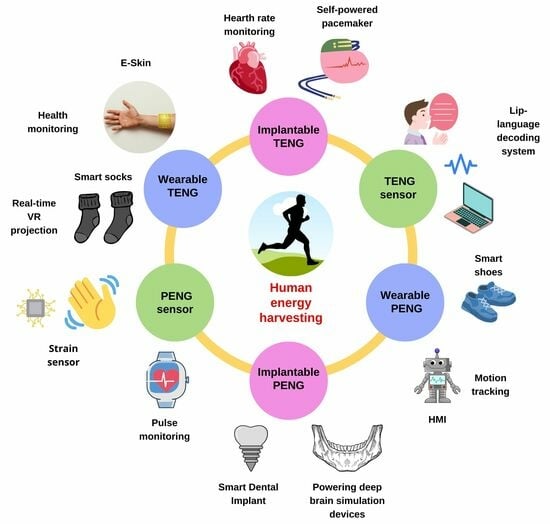A Review of Recent Advances in Human-Motion Energy Harvesting Nanogenerators, Self-Powering Smart Sensors and Self-Charging Electronics
Abstract
:1. Introduction
2. Working Principles and Materials of Energy Harvesting Systems
2.1. PENG-Based Energy Harvesting System
2.1.1. PENG—Working Mechanism and Materials
2.1.2. PENG Energy Harvesting Device System
- Unimorph or bimorph cantilever beam—this consists of one (unimorphic) active piezoelectric material layer placed between two electrodes or two (bimorphic) identical piezoelectric layers and usually a metallic layer in the form of a conductive non-piezoelectric layer placed at one end to create a model working in the bending mode [54,60]. In practice, bimorphic geometry is more commonly used because it can double the energy generated in output power without drastically modifying the device’s volume [54].
- Cymbal transducer—consists of a disk-shaped (usually ceramic) piezoelectric layer installed between two cymbal-shaped metal caps on either side. While the cymbal transducer is subjected to an external lateral force, the metal end caps with cavities act as a mechanical transformer, converting some of the axial stress into the radial stress, which enhances both piezoelectric coefficients—d31 and d33. Thus, the cymbal design can generate higher output energy than a cantilever-type device (up to 100 µW) [50,61].
- Circular diaphragm—consists of a thin disk-shaped piezoelectric layer connected to a metal shim and then clamped to the edges of a clamping ring [53]. To increase the efficiency of the piezoelectric energy harvester at lower frequency levels and increase its output power, a proof mass is attached to the centre of the diaphragm to provide tension to the piezoelectric material [58]. The THUNDER invention represents another method. THUNDER (thin-layer composite ferroelectric unimorphs driver) is a combination of active PZT layers with various inactive metallic materials with high durability and resistance to deformation [62,63].
- Stack configuration—consists of multiple piezoelectric layers stacked on top of each other so that the direction of polarization of each layer is consistent with the applied pressure. The stack configuration is based on the d33 mode, which is particularly useful in applications requiring high pressure. However, the layers require coupling with mechanical amplifiers due to the reduced mechanical energy caused by the greater stiffness of the structural configuration [54].
2.2. TENG-Based Energy Harvesting System
2.2.1. TENG—Working Mechanism and Materials
- (a)
- Kirigami/origami structures—a kirigami structure is created during “folding” and “cutting”, whereas an origami structure is created by “folding” of the material (paper- or plastic-based) [24]. For example, Qi et al. [106] developed a kirigami-inspired TENG where the friction layer was processed into the kirigami configuration with one or two degrees of freedom on a PET sheet by laser cutting technology. The whole structure consisted of PET, Copper, FEP, Acrylic and Sponge materials. This TENG aimed to work as a self-powered acceleration sensor, which can monitor acceleration changes (1–9 m/s2) and harvest ultra-wide-band vibration energy (2–49 Hz).
- (b)
- Textile structures—fibre form, yarn form (converted from fibres) or fabric form (woven or knitted yarn)—1D, 2D or 3D structures that are easy to fabricate at low cost. They are designed to fit with the user’s body while providing functional properties and comfort [24]. Schematic examples of textile-based generators are shown in Figure 7 [79]. The 1D materials fabricated by electrospinning or surface deposition methods are represented by metallic coated yarns and nanotubes which act as stretchable electrodes. The 2D materials in TENG technology represented by MXenes structures acting as a negative triboelectric layer are a promising approach for boosting the power output of TENG [107]. The 3D materials are represented by fabrics made from fibres converted into yarns, knitted, or woven into fabrics. Fibre-based TENGs are designed as a coaxial structure consisting of synthetic polymer fibres acting as triboelectric material (also as carrier and encapsulation layers) and conductive wires (natural or synthetic fibres) acting as electrodes [108]. They have been discussed in detail by Bulathsinghala et al. [24] and Pen et al. [79].
- (c)
- Core-spun/coated textile-based TENGs—among the most complex types of textile-based triboelectric nanogenerators, where multiple layers are integrated into a single material. They typically consist of the conductive layer spun or coated in a thin layer and further spun or coated to create a triboelectric layer in the form of fibre or yarn. Even though compared to other textile-based TENGs their fabrication process is complicated and the energy output is one of the lowest, their advantage is their small size, which helps with integration into clothes [84]. A critical review on the core-spun yarn-based TENGs has been released recently [109].
- (d)
- Electronic skin—wearable thin films and thin sheets or nonwoven composites. As for the flexible thin films or sheets, material combinations are used—PDMS/Cu, PDMS/PET, PDVF/PDMS or PDMS/Nylon. They ensure good electrical output, but the comfort of the person who wears them depends on the structure thickness. Thus, close contact with the contours of the body is limited. In the case of nonwoven composites, fibre assemblies are bonded together by mechanical, chemical or thermal treatments. TENG nonwoven E-skins are breathable, self-cleaning, antibacterial, and comfortable materials produced at high speed and low cost [24]. Electronic skin-based nanogenerators will be more broadly discussed in the section related to application possibilities.
- (e)
- Nonclothing-based shoes—TENGs can be incorporated into a footwear for energy harvesting or sensing purposes. They can be installed above or under the sole, integrated into it or incorporated within the shoe. All of these have been discussed in detail by Dassanayaka et al. [83].
- (f)
- Other configurations—sandwich, honeycomb, ball, nanowires, and others [110].
2.2.2. TENG Energy Harvesting Device System
3. Application of Piezoelectric and Triboelectric Nanogenerators
3.1. Piezoelectric Nanogenerators
3.1.1. Wearable and Implantable Devices
3.1.2. Electronic Skin (E-Skin)
3.1.3. Textile-Based PENG
3.1.4. Self-Powered Sensors
3.1.5. Self-Powered Implantable Electronics
3.1.6. Triboelectric Nanogenerators
Wearable and Implantable Devices
Electronic Skin (E-Skin)
3.1.7. Textile-Based TENG
3.1.8. Self-Powered Sensors
3.1.9. Self-Powered Implantable Electronics
4. Hybrid Systems
5. Comparison between Piezoelectric Nanogenerators and Triboelectric Nanogenerators
6. Challenges and Future Outlooks
- Power management—although high output voltages have been achieved for many nanogenerators, power density needs to be improved to meet real-time power demands in practical applications. In the case of TENG technology, more effort must be put into improving the charge generation, transfer, and collection, to increase conversion efficiency. This is also closely related to the energy-storage system, which is currently primarily based on batteries (both rechargeable and non-rechargeable) or capacitors [202].
- Material selection and environmental factors—materials selected for TENG devices must exhibit mechanical flexibility, elasticity, and durability during mechanical deformation. They must adapt to mechanical damage and maintain performance under various motions such as bending, twisting, and stretching. It is crucial to identify suitable pairs of materials that would exhibit high triboelectric properties. For both TENG and PENG, materials should be stable under varying temperature and humidity conditions and exposure to chemicals, moisture (including human sweat) and contaminants, without losing performance in the long-term operation. Moreover, biocompatibility and biodegradability should be considered when manufacturing implantable and wearable devices in direct contact with human organs and skin that can cause inflammation or infection. More natural materials should be tested and chemically or physically modified to promote their properties [202]. The possibility of recycling, and thus creating green and environmentally friendly PENG and TENG devices, is one way to reduce the amount of waste produced during traditional implantable- and wearable-device manufacturing.
- Design and integration—the device should be lightweight and small, adapting to the shape and movements of the body without hindering it or causing uncomfortable sensations. Integration with textiles and electronic devices requires a well-thought-out view of the entire design, which should combine functionality, comfortability, and aesthetics on one hand, and coexist with necessary and critical parts such as energy storage units, power management and conditioning circuits and other components without interfering with their operation. The cost aspect, however, must be strictly controlled and planned for large-scale production, while maintaining high quality, energy harvesting efficiency and integrity of the overall structure, and at the same time should be available to a broader range of the population [146,202].
- More emphasis should be placed on material selection and structure design to create a system that will operate for a long time without significant performance loss. One idea is to use materials that exhibit self-healing properties as friction layers or fully healable nanogenerators and extend them to large-sized devices [203,204,205,206]. Another idea is to implement 3D-printing method that expands possible application tunability and uses a unique, tailor-made device architecture [207,208,209,210].
- More designs should be created based on a hybrid system that combines the best features of the nanogenerator, which can be a rigid structure with higher power generation on the one hand and a flexible structure for better wearability on the other. The combined nanogenerators produce more electricity per unit volume or unit area than separately. The problems associated with the significant difference in frequency, amplitude and waveform during energy conversion using different transducing methods should be solved to achieve high energy-conversion efficiency when collecting multiple forms of energy from the environment. One promising development is the combination of robotics and energy harvesting based on hybrid systems [211].
- Industrialization—currently, most nanogenerators are hand-made prototypes made in the laboratory that only demonstrate one possible application. Therefore, a standardized manufacturing process for different types of nanogenerators on an industrial scale for commercial application in the future needs to be thought of [84,212]. Moreover, most energy harvesters are intended for special applications such as military or medical. More effort must be made to create devices that the average user will wear—for example, a smartwatch integrated with an energy harvester [213].
- AI, HMI, IoT—with the development of the virtual world, new concepts such as artificial intelligence, the human–machine interface and the Internet of Things have been developed and woven into various aspects of our lives and technology. This is also a very promising way to enrich energy harvesting technology with new application scenarios—wireless signal transmission and multi-dimensional sensing, and visual, auditory, and tactile modes. The devices should be supported by Bluetooth or Wi-Fi communication to monitor and send a real-time signal to the user, for example, regarding their vital signals or position [202].
7. Conclusions
Author Contributions
Funding
Conflicts of Interest
References
- Scarsella, A. Worldwide Mobile Phone Forecast Update, 2021–2025: December 2021. Available online: https://www.idc.com/getdoc.jsp?containerId=US48451521 (accessed on 2 February 2022).
- Poongodi, T.; Krishnamurthi, R.; Indrakumari, R.; Suresh, P.; Balusamy, B. Wearable Devices and IoT; Springer International Publishing: Cham, Switzerland, 2020; Volume 165. [Google Scholar] [CrossRef]
- Industrial Wearable Devices Market in 2022: 7.4% CAGR with Top Countries Data, What Is the Industrial Wearable Devices Industry Growth?|Latest 135 Pages Report—MarketWatch. Available online: https://www.marketwatch.com/press-release/industrial-wearable-devices-market-in-2022-74-cagr-with-top-countries-data-what-is-the-industrial-wearable-devices-industry-growth-latest-135-pages-report-2022-01-21 (accessed on 2 February 2022).
- Ahmed, A.; Azam, A.; Wang, Y.; Zhang, Z.; Li, N.; Jia, C.; Mushtaq, R.T.; Rehman, M.; Gueye, T.; Shahid, M.B.; et al. Additively Manufactured Nano-Mechanical Energy Harvesting Systems: Advancements, Potential Applications, Challenges and Future Perspectives. Nano Converg. 2021, 8, 37. [Google Scholar] [CrossRef]
- Pramanik, P.K.D.; Sinhababu, N.; Mukherjee, B.; Padmanaban, S.; Maity, A.; Upadhyaya, B.K.; Holm-Nielsen, J.B.; Choudhury, P. Power Consumption Analysis, Measurement, Management, and Issues: A State-of-the-Art Review of Smartphone Battery and Energy Usage. IEEE Access 2019, 7, 182113–182172. [Google Scholar] [CrossRef]
- International Energy Agency. Electricity Market Report; No. January; International Energy Agency: Paris, France, 2020. [Google Scholar] [CrossRef]
- Ahmad, T.; Zhang, D. A Critical Review of Comparative Global Historical Energy Consumption and Future Demand: The Story Told so Far. Energy Rep. 2020, 6, 1973–1991. [Google Scholar] [CrossRef]
- Shaikh, F.K.; Zeadally, S. Energy Harvesting in Wireless Sensor Networks: A Comprehensive Review. Renew. Sustain. Energy Rev. 2016, 55, 1041–1054. [Google Scholar] [CrossRef]
- Bjorkqvist, O.; Dahlberg, O.; Silver, G.; Kolitsidas, C.; Quevedo-Teruel, O.; Jonsson, B.L.G. Wireless Sensor Network Utilizing Radio-Frequency Energy Harvesting for Smart Building Applications [Education Corner]. IEEE Antennas. Propag. Mag. 2018, 60, 124–136. [Google Scholar] [CrossRef]
- Yang, S.M.; Lee, T.; Jeng, C.A. Development of a Thermoelectric Energy Harvester with Thermal Isolation Cavity by Standard CMOS Process. Sens. Actuators A Phys. 2009, 153, 244–250. [Google Scholar] [CrossRef]
- Chen, J.; Yang, J.; Li, Z.; Fan, X.; Zi, Y.; Jing, Q.; Guo, H.; Wen, Z.; Pradel, K.C.; Niu, S.; et al. Networks of Triboelectric Nanogenerators for Harvesting Water Wave Energy: A Potential Approach toward Blue Energy. ACS Nano 2015, 9, 3324–3331. [Google Scholar] [CrossRef]
- Wu, Y.; Zhong, X.; Wang, X.; Yang, Y.; Wang, Z.L. Hybrid Energy Cell for Simultaneously Harvesting Wind, Solar, and Chemical Energies. Nano Res. 2014, 7, 1631–1639. [Google Scholar] [CrossRef]
- Choi, Y.M.; Lee, M.G.; Jeon, Y. Wearable Biomechanical Energy Harvesting Technologies. Energies 2017, 10, 1483. [Google Scholar] [CrossRef]
- Ku, M.L.; Li, W.; Chen, Y.; Ray Liu, K.J. Advances in Energy Harvesting Communications: Past, Present, and Future Challenges. IEEE Commun. Surv. Tutor. 2016, 18, 1384–1412. [Google Scholar] [CrossRef]
- Ghomian, T.; Mehraeen, S. Survey of Energy Scavenging for Wearable and Implantable Devices. Energy 2019, 178, 33–49. [Google Scholar] [CrossRef]
- Zhu, M.; Yi, Z.; Yang, B.; Lee, C. Making Use of Nanoenergy from Human—Nanogenerator and Self-Powered Sensor Enabled Sustainable Wireless IoT Sensory Systems. Nano Today 2021, 36, 101016. [Google Scholar] [CrossRef]
- Starner, T. Human-Powered Wearable Computing. IBM Syst. J. 1996, 35, 618–629. [Google Scholar] [CrossRef]
- Liu, L.; Guo, X.; Liu, W.; Lee, C. Recent Progress in the Energy Harvesting Technology—From Self-Powered Sensors to Self-Sustained IoT, and New Applications. Nanomaterials 2021, 11, 2975. [Google Scholar] [CrossRef] [PubMed]
- Venugopal, M.; Jayaramaiah, G.V. Recent Progress on Bio-Mechanical Energy Harvesting System from the Human Body: Comprehensive Review. Int. J. Adv. Comput. Sci. Appl. 2021, 12, 184–194. [Google Scholar] [CrossRef]
- Zou, Y.; Bo, L.; Li, Z. Recent Progress in Human Body Energy Harvesting for Smart Bioelectronic System. Fundam. Res. 2021, 1, 364–382. [Google Scholar] [CrossRef]
- Ramanavicius, S.; Ramanavicius, A. Charge Transfer and Biocompatibility Aspects in Conducting Polymer-Based Enzymatic Biosensors and Biofuel Cells. Nanomaterials 2021, 11, 371. [Google Scholar] [CrossRef] [PubMed]
- Chansaenpak, K.; Kamkaew, A.; Lisnund, S.; Prachai, P.; Ratwirunkit, P.; Jingpho, T.; Blay, V.; Pinyou, P. Development of a Sensitive Self-Powered Glucose Biosensor Based on an Enzymatic Biofuel Cell. Biosensors 2021, 11, 16. [Google Scholar] [CrossRef] [PubMed]
- Osorio-De-La-Rosa, E.; Vazquez-Castillo, J.; Castillo-Atoche, A.; Heredia-Lozano, J.; Castillo-Atoche, A.; Becerra-Nunez, G.; Barbosa, R. Arrays of Plant Microbial Fuel Cells for Implementing Self-Sustainable Wireless Sensor Networks. IEEE Sens. J. 2021, 21, 1965–1974. [Google Scholar] [CrossRef]
- Bulathsinghala, R.L.; Ding, W.; Dharmasena, R.D.I.G. Triboelectric Nanogenerators for Wearable Sensing Applications: A System Level Analysis. Nano Energy 2023, 116, 108792. [Google Scholar] [CrossRef]
- Choi, S. Biofuel Cells and Biobatteries: Misconceptions, Opportunities, and Challenges. Batteries 2023, 9, 119. [Google Scholar] [CrossRef]
- Yadav, A.; Patil, R.; Dutta, S. Advanced Self-Powered Biofuel Cells with Capacitor and Nanogenerator for Biomarker Sensing. ACS Appl. Bio. Mater. 2023, 6, 4060–4080. [Google Scholar] [CrossRef] [PubMed]
- Wu, H.; Zhang, Y.; Kjøniksen, A.L.; Zhou, X.; Zhou, X. Wearable Biofuel Cells: Advances from Fabrication to Application. Adv. Funct. Mater. 2021, 31, 2103976. [Google Scholar] [CrossRef]
- Nozariasbmarz, A.; Collins, H.; Dsouza, K.; Polash, M.H.; Hosseini, M.; Hyland, M.; Liu, J.; Malhotra, A.; Ortiz, F.M.; Mohaddes, F.; et al. Review of Wearable Thermoelectric Energy Harvesting: From Body Temperature to Electronic Systems. Appl. Energy 2020, 258, 114069. [Google Scholar] [CrossRef]
- Parrilla, M.; De Wael, K.; Parrilla, M.; De Wael, K. Wearable Self-Powered Electrochemical Devices for Continuous Health Management. Adv. Funct. Mater. 2021, 31, 2107042. [Google Scholar] [CrossRef]
- Shuvo, M.M.H.; Titirsha, T.; Amin, N.; Islam, S.K. Energy Harvesting in Implantable and Wearable Medical Devices for Enduring Precision Healthcare. Energies 2022, 15, 7495. [Google Scholar] [CrossRef]
- Mondal, R.; Hasan, A.M.; Zhang, R.; Olin, H.; Yang, Y.; Mondal, R.; Hasan, M.A.M.; Yang, Y.; Zhang, R.; Olin, H. Nanogenerators-Based Self-Powered Sensors. Adv. Mater. Technol. 2022, 7, 2200282. [Google Scholar] [CrossRef]
- Thakre, A.; Kumar, A.; Song, H.C.; Jeong, D.Y.; Ryu, J. Pyroelectric Energy Conversion and Its Applications—Flexible Energy Harvesters and Sensors. Sensors 2019, 19, 2170. [Google Scholar] [CrossRef]
- Feng, M.; Lv, S.; Deng, J.; Guo, Y.; Wu, Y.; Shi, G.; Zhang, M. An Overview of Environmental Energy Harvesting by Thermoelectric Generators. Renew. Sustain. Energy Rev. 2023, 187, 113723. [Google Scholar] [CrossRef]
- Korkmaz, S.; Kariper, A. Pyroelectric Nanogenerators (PyNGs) in Converting Thermal Energy into Electrical Energy: Fundamentals and Current Status. Nano Energy 2021, 84, 105888. [Google Scholar] [CrossRef]
- Mondal, R.; Hasan, M.A.M.; Baik, J.M.; Yang, Y. Advanced Pyroelectric Materials for Energy Harvesting and Sensing Applications. Mater. Today 2023, 66, 273–301. [Google Scholar] [CrossRef]
- Panda, S.; Hajra, S.; Song, H.; Jo, J.; Kim, N.; Hwang, S.; Choi, Y.; Kim, H.G.; Kim, H.J.; Mishra, Y.K. Pyroelectric Based Energy Harvesting Devices: Hybrid Structures and Applications. Sustain. Energy Fuels 2023, 7, 5319–5335. [Google Scholar] [CrossRef]
- Jouhara, H.; Żabnieńska-Góra, A.; Khordehgah, N.; Doraghi, Q.; Ahmad, L.; Norman, L.; Axcell, B.; Wrobel, L.; Dai, S. Thermoelectric Generator (TEG) Technologies and Applications. Int. J. Thermofluids 2021, 9, 100063. [Google Scholar] [CrossRef]
- Zoui, M.A.; Bentouba, S.; Stocholm, J.G.; Bourouis, M. A Review on Thermoelectric Generators: Progress and Applications. Energies 2020, 13, 3606. [Google Scholar] [CrossRef]
- Tohidi, F.; Ghazanfari Holagh, S.; Chitsaz, A. Thermoelectric Generators: A Comprehensive Review of Characteristics and Applications. Appl. Therm. Eng. 2022, 201, 117793. [Google Scholar] [CrossRef]
- Kim, H.S.; Kim, J.H.; Kim, J. A Review of Piezoelectric Energy Harvesting Based on Vibration. Int. J. Precis. Eng. Manuf. 2011, 12, 1129–1141. [Google Scholar] [CrossRef]
- Wang, S.; Lin, L.; Wang, Z.L. Nanoscale Triboelectric-Effect-Enabled Energy Conversion for Sustainably Powering Portable Electronics. Nano Lett. 2012, 12, 6339–6346. [Google Scholar] [CrossRef]
- Briscoe, J.; Dunn, S. Piezoelectric Nanogenerators—A Review of Nanostructured Piezoelectric Energy Harvesters. Nano Energy 2015, 14, 15–29. [Google Scholar] [CrossRef]
- Wang, Z.L.; Zhu, G.; Yang, Y.; Wang, S.; Pan, C. Progress in Nanogenerators for Portable Electronics. Mater. Today 2012, 15, 532–543. [Google Scholar] [CrossRef]
- Wang, Z.L.; Chen, J.; Lin, L. Progress in Triboelectric Nanogenerators as a New Energy Technology and Self-Powered Sensors. Energy Environ. Sci. 2015, 8, 2250–2282. [Google Scholar] [CrossRef]
- Fan, F.R.; Tian, Z.Q.; Lin Wang, Z. Flexible Triboelectric Generator. Nano Energy 2012, 1, 328–334. [Google Scholar] [CrossRef]
- Dai, X.; Han, J.; Zheng, Q.; Zhao, C.; Huang, L. Functional Polymer Nanocomposite for Triboelectric Nanogenerators. In Polymer Nanocomposite Materials; Wiley: New York, NY, USA, 2021; pp. 189–210. [Google Scholar] [CrossRef]
- Yang, Y.; Xie, L.; Wen, Z.; Chen, C.; Chen, X.; Wei, A.; Cheng, P.; Xie, X.; Sun, X. Coaxial Triboelectric Nanogenerator and Supercapacitor Fiber-Based Self-Charging Power Fabric. ACS Appl. Mater. Interfaces 2018, 10, 42356–42362. [Google Scholar] [CrossRef]
- Huang, L.; Lin, S.; Xu, Z.; Zhou, H.; Duan, J.; Hu, B.; Zhou, J. Fiber-Based Energy Conversion Devices for Human-Body Energy Harvesting. Adv. Mater. 2020, 32, 1902034. [Google Scholar] [CrossRef]
- Kazmierski, T.J.; Beeby, S. Energy Harvesting Systems: Principles, Modeling and Applications; Springer Science+Business Media, LLC: New York, NY, USA, 2011; Available online: https://scholar.google.pl/scholar?q=50.+Kazmierski,+T.J.%3B+Beeby,+S.+Energy+Harvesting+Systems:+Principles,+Modeling+and+Applications&hl=en&as_sdt=0&as_vis=1&oi=scholart (accessed on 8 November 2023).
- Sezer, N.; Koç, M. A Comprehensive Review on the State-of-the-Art of Piezoelectric Energy Harvesting. Nano Energy 2021, 80, 105567. [Google Scholar] [CrossRef]
- Liu, H.; Zhong, J.; Lee, C.; Lee, S.W.; Lin, L. A Comprehensive Review on Piezoelectric Energy Harvesting Technology: Materials, Mechanisms, and Applications. Appl. Phys. Rev. 2018, 5, 041306. [Google Scholar] [CrossRef]
- Ahmed, R.; Mir, F.; Banerjee, S. A Review on Energy Harvesting Approaches for Renewable Energies from Ambient Vibrations and Acoustic Waves Using Piezoelectricity. Smart Mater. Struct. 2017, 26, 085031. [Google Scholar] [CrossRef]
- Khalid, S.; Raouf, I.; Khan, A.; Kim, N.; Kim, H.S. A Review of Human-Powered Energy Harvesting for Smart Electronics: Recent Progress and Challenges. Int. J. Precis. Eng. Manuf.-Green Technol. 2019, 6, 821. [Google Scholar] [CrossRef]
- Mishra, S.; Unnikrishnan, L.; Nayak, S.K.; Mohanty, S. Advances in Piezoelectric Polymer Composites for Energy Harvesting Applications: A Systematic Review. In Macromolecular Materials and Engineering; Wiley-VCH: Hoboken, NJ, USA, 2019. [Google Scholar] [CrossRef]
- Rödel, J.; Webber, K.G.; Dittmer, R.; Jo, W.; Kimura, M.; Damjanovic, D. Transferring Lead-Free Piezoelectric Ceramics into Application. J. Eur. Ceram Soc. 2015, 35, 1659–1681. [Google Scholar] [CrossRef]
- Covaci, C.; Gontean, A. Piezoelectric Energy Harvesting Solutions: A Review. Sensors 2020, 20, 3512. [Google Scholar] [CrossRef]
- Liu, Y.; Wang, L.; Zhao, L.; Yu, X.; Zi, Y. Recent Progress on Flexible Nanogenerators toward Self-Powered Systems. InfoMat 2020, 2, 318–340. [Google Scholar] [CrossRef]
- Li, H.; Tian, C.; Deng, Z.D. Energy Harvesting from Low Frequency Applications Using Piezoelectric Materials. Appl. Phys. Rev. 2014, 1, 041301. [Google Scholar] [CrossRef]
- Gareh, S.; Kok, B.; Uttraphan, C.; Thong, K.; Borhana, A.; Raja Batu Pahat, P.; Darul Ehsan, S. Evaluation of Piezoelectric Energy Harvester Outcomes in Road Traffic Applications. In Proceedings of the 4th IET Clean Energy and Technology Conference (CEAT 2016), Kuala Lumpur, Malaysia, 14–15 November 2016. [Google Scholar]
- Li, L.; Xu, J.; Liu, J.; Gao, F. Recent Progress on Piezoelectric Energy Harvesting: Structures and Materials. In Advanced Composites and Hybrid Materials; Springer International Publishing AG: Berlin/Heidelberg, Germany, 2018; Volume 1, pp. 478–505. [Google Scholar] [CrossRef]
- Kim, H.W.; Batra, A.; Priya, S.; Uchino, K.; Markley, D.; Newnham, R.E.; Hofmann, H.F. Energy Harvesting Using a Piezoelectric “Cymbal” Transducer in Dynamic Environment. Jpn. J. Appl. Phys. Part 1 Regul. Pap. Short Notes Rev. Pap. 2004, 43, 6178–6183. [Google Scholar] [CrossRef]
- Mane, P.; Mossi, K.; Green, C.; Bryant, R. Studying the Effects of Temperature on Energy Harvesting Using Pre-Stressed Piezoelectric Diaphragms. In Behavior and Mechanics of Multifunctional and Composite Materials; Proc. SPIE 6526; SPIE: Bellingham, DC, USA, 2007; p. 65260K. [Google Scholar] [CrossRef]
- Carazo, A.V. Revolutionary Innovations in Piezoelectric Actuators and Transformers at FACE. 2003. Available online: https://apps.dtic.mil/sti/citations/ADA429545 (accessed on 8 November 2022).
- Wang, Z.L.; Wu, W. Nanotechnology-Enabled Energy Harvesting for Self-Powered Micro-/Nanosystems. Angew. Chem. Int. Ed. 2012, 51, 11700–11721. [Google Scholar] [CrossRef] [PubMed]
- Zou, Y.; Libanori, A.; Xu, J.; Nashalian, A.; Chen, J. Triboelectric Nanogenerator Enabled Smart Shoes for Wearable Electricity Generation. Research 2020, 7158953. [Google Scholar] [CrossRef] [PubMed]
- Yang, H.; Fan, F.R.; Xi, Y.; Wu, W. Bio-Derived Natural Materials Based Triboelectric Devices for Self-Powered Ubiquitous Wearable and Implantable Intelligent Devices. Adv. Sustain. Syst. 2020, 4, 2000108. [Google Scholar] [CrossRef]
- Feng, X.; Zhang, Y.; Kang, L.; Wang, L.; Duan, C.; Yin, K.; Pang, J.; Wang, K. Integrated Energy Storage System Based on Triboelectric Nanogenerator in Electronic Devices. Front. Chem. Sci. Eng. 2021, 15, 238–250. [Google Scholar] [CrossRef]
- Kwak, S.S.; Yoon, H.J.; Kim, S.W. Textile-Based Triboelectric Nanogenerators for Self-Powered Wearable Electronics. Adv. Funct. Mater. 2019, 29, 1804533. [Google Scholar] [CrossRef]
- Bu, C.; Li, F.; Yin, K.; Pang, J.; Wang, L.; Wang, K. Research Progress and Prospect of Triboelectric Nanogenerators as Self-Powered Human Body Sensors. ACS Appl. Electron. Mater. 2020, 2, 863–878. [Google Scholar] [CrossRef]
- Huang, T.; Wang, C.; Yu, H.; Wang, H.; Zhang, Q.; Zhu, M. Human Walking-Driven Wearable All-Fiber Triboelectric Nanogenerator Containing Electrospun Polyvinylidene Fluoride Piezoelectric Nanofibers. Nano Energy 2014, 14, 226–235. [Google Scholar] [CrossRef]
- Yang, Y.; Zhang, H.; Lin, Z.H.; Zhou, Y.S.; Jing, Q.; Su, Y.; Yang, J.; Chen, J.; Hu, C.; Wang, Z.L. Human Skin Based Triboelectric Nanogenerators for Harvesting Biomechanical Energy and as Self-Powered Active Tactile Sensor System. ACS Nano 2013, 7, 9213–9222. [Google Scholar] [CrossRef]
- Zhou, L.; Liu, D.; Wang, J.; Wang, Z.L. Triboelectric Nanogenerators: Fundamental Physics and Potential Applications. Friction 2020, 8, 481–506. [Google Scholar] [CrossRef]
- Wang, S.; Lin, L.; Xie, Y.; Jing, Q.; Niu, S.; Wang, Z.L. Sliding-Triboelectric Nanogenerators Based on in-Plane Charge-Separation Mechanism. Nano Lett. 2013, 13, 2226–2233. [Google Scholar] [CrossRef]
- Ahmed, A.; Hassan, I.; Mosa, I.M.; Elsanadidy, E.; Phadke, G.S.; El-Kady, M.F.; Rusling, J.F.; Selvaganapathy, P.R.; Kaner, R.B. All Printable Snow-Based Triboelectric Nanogenerator. Nano Energy 2019, 60, 17–25. [Google Scholar] [CrossRef] [PubMed]
- Gogurla, N.; Roy, B.; Park, J.Y.; Kim, S. Skin-Contact Actuated Single-Electrode Protein Triboelectric Nanogenerator and Strain Sensor for Biomechanical Energy Harvesting and Motion Sensing. Nano Energy 2019, 62, 674–681. [Google Scholar] [CrossRef]
- Wu, Y.; Jing, Q.; Chen, J.; Bai, P.; Bai, J.; Zhu, G.; Su, Y.; Wang, Z.L. A Self-Powered Angle Measurement Sensor Based on Triboelectric Nanogenerator. Adv. Funct. Mater. 2015, 25, 2166–2174. [Google Scholar] [CrossRef]
- Chen, S.W.; Cao, X.; Wang, N.; Ma, L.; Zhu, H.R.; Willander, M.; Jie, Y.; Wang, Z.L.; Chen, S.W.; Cao, X.; et al. An Ultrathin Flexible Single-Electrode Triboelectric-Nanogenerator for Mechanical Energy Harvesting and Instantaneous Force Sensing. Adv. Energy Mater. 2017, 7, 1601255. [Google Scholar] [CrossRef]
- Wang, S.; Xie, Y.; Niu, S.; Lin, L.; Lin Wang, Z.; Wang, S.; Xie, Y.; Niu, S.; Lin, L.; Wang, Z.L. Freestanding Triboelectric-Layer-Based Nanogenerators for Harvesting Energy from a Moving Object or Human Motion in Contact and Non-Contact Modes. Adv. Mater. 2014, 26, 2818–2824. [Google Scholar] [CrossRef] [PubMed]
- Peng, Y.; Wang, Z.; Shao, Y.; Xu, J.; Wang, X.; Hu, J.; Zhang, K.-Q.; Peng, Y.; Wang, Z.; Shao, Y.; et al. A Review of Recent Development of Wearable Triboelectric Nanogenerators Aiming at Human Clothing for Energy Conversion. Polymers 2023, 15, 508. [Google Scholar] [CrossRef]
- Ning, C.; Zheng, G.; Dong, K.; Ning, C.; Zheng, G.; Dong, K. Emerging Self-Powered Autonomous Sensing Triboelectric Fibers toward Future Wearable Human-Computer Interaction Devices. Adv. Sens. Res. 2023, 2, 2200044. [Google Scholar] [CrossRef]
- Wang, H.; Han, M.; Song, Y.; Zhang, H. Design, Manufacturing and Applications of Wearable Triboelectric Nanogenerators. Nano Energy 2021, 81, 105627. [Google Scholar] [CrossRef]
- Zhao, Z.; Lu, Y.; Mi, Y.; Meng, J.; Cao, X.; Wang, N. Structural Flexibility in Triboelectric Nanogenerators: A Review on the Adaptive Design for Self-Powered Systems. Micromachines 2022, 13, 1586. [Google Scholar] [CrossRef]
- Dassanayaka, D.G.; Alves, T.M.; Wanasekara, N.D.; Dharmasena, I.G.; Ventura, J.; Dassanayaka, D.G.; Wanasekara, N.D.; Dharmasena, I.G.; Alves, T.M.; Ventura, J. Recent Progresses in Wearable Triboelectric Nanogenerators. Adv. Funct. Mater. 2022, 32, 2205438. [Google Scholar] [CrossRef]
- Walden, R.; Aazem, I.; Babu, A.; Pillai, S.C. Textile-Triboelectric Nanogenerators (T-TENGs) for Wearable Energy Harvesting Devices. Chem. Eng. J. 2023, 451, 138741. [Google Scholar] [CrossRef]
- Chen, L.; Shi, Q.; Sun, Y.; Nguyen, T.; Lee, C.; Soh, S. Controlling Surface Charge Generated by Contact Electrification: Strategies and Applications. Adv. Mater. 2018, 30, 1802405. [Google Scholar] [CrossRef] [PubMed]
- Chen, H.; Lu, Q.; Cao, X.; Wang, N.; Wang, Z.L. Natural Polymers Based Triboelectric Nanogenerator for Harvesting Biomechanical Energy and Monitoring Human Motion. Nano Res. 2021, 15, 2505–2511. [Google Scholar] [CrossRef]
- Xia, R.; Zhang, R.; Jie, Y.; Zhao, W.; Cao, X.; Wang, Z. Natural Cotton-Based Triboelectric Nanogenerator as a Self-Powered System for Efficient Use of Water and Wind Energy. Nano Energy 2022, 92, 106685. [Google Scholar] [CrossRef]
- Jo, S.; Kim, I.; Jayababu, N.; Roh, H.; Kim, Y.; Kim, D. Antibacterial and Soluble Paper-Based Skin-Attachable Human Motion Sensor Using Triboelectricity. ACS Sustain. Chem. Eng. 2020, 8, 10786–10794. [Google Scholar] [CrossRef]
- Zargari, S.; Daie Koozehkanani, Z.; Veladi, H.; Sobhi, J.; Rezania, A. A New Mylar-Based Triboelectric Energy Harvester with an Innovative Design for Mechanical Energy Harvesting Applications. Energy Convers. Manag. 2021, 244, 114489. [Google Scholar] [CrossRef]
- Zhang, P.; Zhang, Z.; Cai, J. A Foot Pressure Sensor Based on Triboelectric Nanogenerator for Human Motion Monitoring. Microsyst. Technol. 2021, 27, 3507–3512. [Google Scholar] [CrossRef]
- Mao, Y.; Li, Y.; Xie, J.; Liu, H.; Guo, C.; Hu, W. Triboelectric Nanogenerator/Supercapacitor in-One Self-Powered Textile Based on PTFE Yarn Wrapped PDMS/MnO2NW Hybrid Elastomer. Nano Energy 2021, 84, 105918. [Google Scholar] [CrossRef]
- Wang, J.; Xia, Z.; Yao, H.; Zhang, Q.; Yang, H. Self-Powered TENG with High Humidity Sensitivity from PVA Film Modified by LiCl and MXene. ACS Appl. Mater. Interfaces 2023, 15, 47208–47220. [Google Scholar] [CrossRef] [PubMed]
- Park, M.; Cho, S.; Yun, Y.; La, M.; Park, S.J.; Choi, D. A Highly Sensitive Magnetic Configuration-Based Triboelectric Nanogenerator for Multidirectional Vibration Energy Harvesting and Self-Powered Environmental Monitoring. Int. J. Energy Res. 2021, 45, 18262–18274. [Google Scholar] [CrossRef]
- Zhao, S. A Triboelectric Nanogenerator Based on MgSiO3 Powder for a Human Motion Counter. J. Electron. Mater. 2021, 50, 6836–6843. [Google Scholar] [CrossRef]
- Ma, G.; Li, B.; Niu, S.; Zhang, J.; Wang, D.; Wang, Z.; Zhou, L.; Liu, Q.; Liu, L.; Wang, J.; et al. A Bioinspired Triboelectric Nanogenerator for All State Energy Harvester and Self-Powered Rotating Monitor. Nano Energy 2022, 91, 106637. [Google Scholar] [CrossRef]
- Shabbir, I.; Lee, D.M.; Choo, D.C.; Lee, Y.H.; Park, K.K.; Yoo, K.H.; Kim, S.W.; Kim, T.W. A Graphene Nanoplatelets-Based High-Performance, Durable Triboelectric Nanogenerator for Harvesting the Energy of Human Motion. Energy Rep. 2022, 8, 1026–1033. [Google Scholar] [CrossRef]
- Yang, C.R.; Ko, C.T.; Chang, S.F.; Huang, M.J. Study on Fabric-Based Triboelectric Nanogenerator Using Graphene Oxide/Porous PDMS as a Compound Friction Layer. Nano Energy 2022, 92, 106791. [Google Scholar] [CrossRef]
- Vijoy, K.V.; John, H.; Saji, K.J. Self-Powered Ultra-Sensitive Millijoule Impact Sensor Using Room Temperature Cured PDMS Based Triboelectric Nanogenerator. Microelectron. Eng. 2022, 251, 111664. [Google Scholar] [CrossRef]
- Ko, H.J.; Kwon, D.S.; Bae, K.; Kim, J. Self-Suspended Shell-Based Triboelectric Nanogenerator for Omnidirectional Wind-Energy Harvesting. Nano Energy 2022, 96, 107062. [Google Scholar] [CrossRef]
- Lv, S.; Huang, T.; Yu, H. Silicon Rubber/Expandable Microsphere Based Triboelectric Nanogenerator for Harvesting Biomechanical Energy. J. Phys. Conf. Ser. 2021, 2076, 012098. [Google Scholar] [CrossRef]
- Zeng, Y.; Xiang, H.; Zheng, N.; Cao, X.; Wang, N.; Wang, Z.L. Flexible Triboelectric Nanogenerator for Human Motion Tracking and Gesture Recognition. Nano Energy 2022, 91, 106601. [Google Scholar] [CrossRef]
- Park, H.W.; Huynh, N.D.; Kim, W.; Hwang, H.J.; Hong, H.; Choi, K.H.; Song, A.; Chung, K.B.; Choi, D. Effects of Embedded TiO2−x Nanoparticles on Triboelectric Nanogenerator Performance. Micromachines 2018, 9, 407. [Google Scholar] [CrossRef] [PubMed]
- Gao, L.; Li, J.; Wang, Z.; Bu, M.; Zhai, L.; Wu, S.; Hu, N.; Dai, K.; Wu, L.; Lee, A.; et al. A High Performance Triboelectric Nanogenerator Based on Ordered Doping Technique for Human-Machine Interaction Sensing. Nano Energy 2022, 95, 107025. [Google Scholar] [CrossRef]
- Chekke, T.; Narzary, R.; Ngadong, S.; Satpati, B.; Bayan, S.; Das, U. Cotton Based Self-Powered Temperature Sensor Based on Au-Augmented WS2 Triboelectric Nanogenerator. J. Electron. Mater. 2024, 53, 238–249. [Google Scholar] [CrossRef]
- Shi, Q.; He, T.; Lee, C. More than Energy Harvesting—Combining Triboelectric Nanogenerator and Flexible Electronics Technology for Enabling Novel Micro-/Nano-Systems. Nano Energy 2019, 57, 851–871. [Google Scholar] [CrossRef]
- Qi, Y.; Kuang, Y.; Liu, Y.; Liu, G.; Zeng, J.; Zhao, J.; Wang, L.; Zhu, M.; Zhang, C. Kirigami-Inspired Triboelectric Nanogenerator as Ultra-Wide-Band Vibrational Energy Harvester and Self-Powered Acceleration Sensor. Appl. Energy 2022, 327, 120092. [Google Scholar] [CrossRef]
- Salauddin, M.; Rana, S.M.S.; Rahman, M.T.; Sharifuzzaman, M.; Maharjan, P.; Bhatta, T.; Cho, H.; Lee, S.H.; Park, C.; Shrestha, K.; et al. Fabric-Assisted MXene/Silicone Nanocomposite-Based Triboelectric Nanogenerators for Self-Powered Sensors and Wearable Electronics. Adv. Funct. Mater. 2022, 32, 2107143. [Google Scholar] [CrossRef]
- Xiong, J.; Lee, P.S. Progress on Wearable Triboelectric Nanogenerators in Shapes of Fiber, Yarn, and Textile. Sci. Technol. Adv. Mater. 2019, 20, 837–857. [Google Scholar] [CrossRef]
- Aliyana, A.K.; Stylios, G. A Review on the Progress in Core-Spun Yarns (CSYs) Based Textile TENGs for Real-Time Energy Generation, Capture and Sensing. Adv. Sci. 2023, 10, 2304232. [Google Scholar] [CrossRef]
- Zhang, Q.; Xin, C.; Shen, F.; Gong, Y.; Zi, Y.L.; Guo, H.; Li, Z.; Peng, Y.; Zhang, Q.; Wang, Z.L. Human Body IoT Systems Based on the Triboelectrification Effect: Energy Harvesting, Sensing, Interfacing and Communication. Energy Environ. Sci. 2022, 15, 3688–3721. [Google Scholar] [CrossRef]
- Yan, R.; Sun, Q.; Shi, X.; Sun, Z.; Tan, S.; Tang, B.; Chen, W.; Liang, F.; Yu, H.D.; Huang, W. Skin-Interfaced Self-Powered Pressure and Strain Sensors Based on Fish Gelatin-Based Hydrogel for Wireless Wound Strain and Human Motion Detection. Nano Energy 2023, 118, 108932. [Google Scholar] [CrossRef]
- Shi, X.; Wei, Y.; Yan, R.; Hu, L.; Zhi, J.; Tang, B.; Li, Y.; Yao, Z.; Shi, C.; Yu, H.D.; et al. Leaf Surface-Microstructure Inspired Fabrication of Fish Gelatin-Based Triboelectric Nanogenerator. Nano Energy 2023, 109, 108231. [Google Scholar] [CrossRef]
- Yang, Y.; Chen, L.; He, J.; Hou, X.; Qiao, X.; Xiong, J.; Chou, X.; Yang, Y.; Chen, L.; He, J.; et al. Flexible and Extendable Honeycomb-Shaped Triboelectric Nanogenerator for Effective Human Motion Energy Harvesting and Biomechanical Sensing. Adv. Mater. Technol. 2022, 7, 2100702. [Google Scholar] [CrossRef]
- Liu, J.; Li, S.; Yang, M.; Wang, Y.; Cui, N.; Gu, L. Coaxial Spring-Like Stretchable Triboelectric Nanogenerator Toward Personal Healthcare Monitoring. Front. Bioeng. Biotechnol. 2022, 10, 530. [Google Scholar] [CrossRef]
- Li, H.; Zhang, Y.; Wu, Y.; Zhao, H.; Wang, W.; He, X.; Zheng, H. A Stretchable Triboelectric Nanogenerator Made of Silver-Coated Glass Microspheres for Human Motion Energy Harvesting and Self-Powered Sensing Applications. Beilstein J. Nanotechnol. 2021, 12, 402–412. [Google Scholar] [CrossRef]
- Xu, F.; Dong, S.; Liu, G.; Pan, C.; Guo, Z.H.; Guo, W.; Li, L.; Liu, Y.; Zhang, C.; Pu, X.; et al. Scalable Fabrication of Stretchable and Washable Textile Triboelectric Nanogenerators as Constant Power Sources for Wearable Electronics. Nano Energy 2021, 88, 106247. [Google Scholar] [CrossRef]
- Jiang, Y.; Dong, K.; Li, X.; An, J.; Wu, D.; Peng, X.; Yi, J.; Ning, C.; Cheng, R.; Yu, P.; et al. Stretchable, Washable, and Ultrathin Triboelectric Nanogenerators as Skin-Like Highly Sensitive Self-Powered Haptic Sensors. Adv. Funct. Mater. 2021, 31, 2005584. [Google Scholar] [CrossRef]
- Feng, Y.; Yu, J.; Sun, D.; Dang, C.; Ren, W.; Shao, C.; Sun, R. Extreme Environment-Adaptable and Fast Self-Healable Eutectogel Triboelectric Nanogenerator for Energy Harvesting and Self-Powered Sensing. Nano Energy 2022, 98, 107284. [Google Scholar] [CrossRef]
- Dong, L.; Wang, M.; Wu, J.; Zhu, C.; Shi, J.; Morikawa, H. Stretchable, Adhesive, Self-Healable, and Conductive Hydrogel-Based Deformable Triboelectric Nanogenerator for Energy Harvesting and Human Motion Sensing. ACS Appl. Mater. Interfaces 2022, 14, 9126–9137. [Google Scholar] [CrossRef] [PubMed]
- Wu, Y.; Luo, Y.; Qu, J.; Daoud, W.A.; Qi, T. Sustainable and Shape-Adaptable Liquid Single-Electrode Triboelectric Nanogenerator for Biomechanical Energy Harvesting. Nano Energy 2020, 75, 105027. [Google Scholar] [CrossRef]
- Wang, L.; Liu, W.; Yan, Z.; Wang, F.; Wang, X. Stretchable and Shape-Adaptable Triboelectric Nanogenerator Based on Biocompatible Liquid Electrolyte for Biomechanical Energy Harvesting and Wearable Human–Machine Interaction. Adv. Funct. Mater. 2021, 31, 2007221. [Google Scholar] [CrossRef]
- Zheng, N.; Xue, J.; Jie, Y.; Cao, X.; Wang, Z.L. Wearable and Humidity-Resistant Biomaterials-Based Triboelectric Nanogenerator for High Entropy Energy Harvesting and Self-Powered Sensing. Nano Res. 2022, 15, 6213–6219. [Google Scholar] [CrossRef]
- Zu, G.; Wei, Y.; Sun, C.; Yang, X. Humidity-Resistant, Durable, Wearable Single-Electrode Triboelectric Nanogenerator for Mechanical Energy Harvesting. J. Mater. Sci. 2022, 57, 2813–2824. [Google Scholar] [CrossRef]
- Zhang, Q.; Zhang, Z.; Liang, Q.; Gao, F.; Yi, F.; Ma, M.; Liao, Q.; Kang, Z.; Zhang, Y. Green Hybrid Power System Based on Triboelectric Nanogenerator for Wearable/Portable Electronics. Nano Energy 2019, 55, 151–163. [Google Scholar] [CrossRef]
- Zhang, N.; Tao, C.; Fan, X.; Chen, J. Progress in Triboelectric Nanogenerators as Self-Powered Smart Sensors. J. Mater. Res. 2017, 32, 1628–1646. [Google Scholar] [CrossRef]
- Deng, W.; Zhou, Y.; Zhao, X.; Zhang, S.; Zou, Y.; Xu, J.; Yeh, M.H.; Guo, H.; Chen, J. Ternary Electrification Layered Architecture for High-Performance Triboelectric Nanogenerators. ACS Nano 2020, 14, 9050–9058. [Google Scholar] [CrossRef] [PubMed]
- Kim, W.G.; Kim, D.W.; Tcho, I.W.; Kim, J.K.; Kim, M.S.; Choi, Y.K. Triboelectric Nanogenerator: Structure, Mechanism, and Applications. ACS Nano 2021, 15, 258–287. [Google Scholar] [CrossRef]
- He, W.; Fu, X.; Zhang, D.; Zhang, Q.; Zhuo, K.; Yuan, Z.; Ma, R. Recent Progress of Flexible/Wearable Self-Charging Power Units Based on Triboelectric Nanogenerators. Nano Energy 2021, 84, 105880. [Google Scholar] [CrossRef]
- Wearable Technology Market Share & Trends Report. 2030. Available online: https://www.grandviewresearch.com/industry-analysis/wearable-technology-market (accessed on 9 May 2023).
- Implantable Medical Devices Market Size, Report 2022 to 2030. Available online: https://www.precedenceresearch.com/implantable-medical-devices-market (accessed on 9 May 2023).
- Medical Sensors Market Revenue Trends and Growth Drivers|Markets and Markets. Available online: https://www.marketsandmarkets.com/Market-Reports/sensors-market-healthcare-applications-372.html?gclid=CjwKCAjw3ueiBhBmEiwA4BhspIydkhFbc6wrW-51-_0uTWWMMbLhQlHYXwn58CPRKCtlgncekfyWIBoCbWQQAvD_BwE (accessed on 9 May 2023).
- Wu, Z.; Cheng, T.; Wang, Z.L. Self-Powered Sensors and Systems Based on Nanogenerators. Sensors 2020, 20, 2925. [Google Scholar] [CrossRef]
- Yang, M.; Liu, J.; Liu, D.; Jiao, J.; Cui, N.; Liu, S.; Xu, Q.; Gu, L.; Qin, Y. A Fully Self-Healing Piezoelectric Nanogenerator for Self-Powered Pressure Sensing Electronic Skin. Research 2021, 2021, 9793458. [Google Scholar] [CrossRef]
- Zhang, M.; Wang, W.; Xia, G.; Wang, L.; Wang, K. Self-Powered Electronic Skin for Remote Human-Machine Synchronization. ACS Appl. Electron. Mater. 2022, 5, 508. [Google Scholar] [CrossRef]
- Mokhtari, F.; Foroughi, J.; Zheng, T.; Cheng, Z.; Spinks, G.M. Triaxial Braided Piezo Fiber Energy Harvesters for Self-Powered Wearable Technologies. J. Mater. Chem. A Mater. 2019, 7, 8245–8257. [Google Scholar] [CrossRef]
- Guo, Y.; Zhang, X.S.; Wang, Y.; Gong, W.; Zhang, Q.; Wang, H.; Brugger, J. All-Fiber Hybrid Piezoelectric-Enhanced Triboelectric Nanogenerator for Wearable Gesture Monitoring. Nano Energy 2018, 48, 152–160. [Google Scholar] [CrossRef]
- Ponnamma, D.; Parangusan, H.; Tanvir, A.; AlMa’adeed, M.A.A. Smart and Robust Electrospun Fabrics of Piezoelectric Polymer Nanocomposite for Self-Powering Electronic Textiles. Mater. Des. 2019, 184, 108176. [Google Scholar] [CrossRef]
- Rafique, S.; Kasi, A.K.; Kasi, J.K.; Aminullah; Bokhari, M.; Shakoor, Z. Fabrication of Silver-Doped Zinc Oxide Nanorods Piezoelectric Nanogenerator on Cotton Fabric to Utilize and Optimize the Charging System. Nanomater. Nanotechnol. 2020, 10. [Google Scholar] [CrossRef]
- He, Q.; Li, X.; Zhang, J.; Zhang, H.; Briscoe, J. P–N Junction-Based ZnO Wearable Textile Nanogenerator for Biomechanical Energy Harvesting. Nano Energy 2021, 85, 105938. [Google Scholar] [CrossRef]
- Zhou, H.; Zhang, Y.; Qiu, Y.; Wu, H.; Qin, W.; Liao, Y.; Yu, Q.; Cheng, H. Stretchable Piezoelectric Energy Harvesters and Self-Powered Sensors for Wearable and Implantable Devices. Biosens. Bioelectron. 2020, 168, 112569. [Google Scholar] [CrossRef]
- Jin, L.; Ma, S.; Deng, W.; Yan, C.; Yang, T.; Chu, X.; Tian, G.; Xiong, D.; Lu, J.; Yang, W. Polarization-Free High-Crystallization β-PVDF Piezoelectric Nanogenerator toward Self-Powered 3D Acceleration Sensor. Nano Energy 2018, 50, 632–638. [Google Scholar] [CrossRef]
- Yang, Y.; Pan, H.; Xie, G.; Jiang, Y.; Chen, C.; Su, Y.; Wang, Y.; Tai, H. Flexible Piezoelectric Pressure Sensor Based on Polydopamine-Modified BaTiO3/PVDF Composite Film for Human Motion Monitoring. Sens. Actuators A Phys. 2020, 301, 111789. [Google Scholar] [CrossRef]
- Wu, H.S.; Wei, S.M.; Chen, S.W.; Pan, H.C.; Pan, W.P.; Huang, S.M.; Tsai, M.L.; Yang, P.K. Metal-Free Perovskite Piezoelectric Nanogenerators for Human–Machine Interfaces and Self-Powered Electrical Stimulation Applications. Adv. Sci. 2022, 9, 2105974. [Google Scholar] [CrossRef] [PubMed]
- Su, C.; Huang, X.; Zhang, L.; Zhang, Y.; Yu, Z.; Chen, C.; Ye, Y.; Guo, S. Robust Superhydrophobic Wearable Piezoelectric Nanogenerators for Self-Powered Body Motion Sensors. Nano Energy 2023, 107, 108095. [Google Scholar] [CrossRef]
- Nair, N.M.; Deswal, S.; Dahiya, R. Transparent Piezoelectric Nanogenerator for Self-Powered Force Sensing Applications. IEEE Sens. Lett. 2023, 7, 2501004. [Google Scholar] [CrossRef]
- Khan, A.; Joshi, R.; Sharma, M.K.; Ganguly, A.; Parashar, P.; Wang, T.W.; Lee, S.; Kao, F.C.; Lin, Z.H. Piezoelectric and Triboelectric Nanogenerators: Promising Technologies for Self-Powered Implantable Biomedical Devices. Nano Energy 2024, 119, 109051. [Google Scholar] [CrossRef]
- Parvez Mahmud, M.A.; Huda, N.; Farjana, S.H.; Asadnia, M.; Lang, C. Recent Advances in Nanogenerator-Driven Self-Powered Implantable Biomedical Devices. Adv. Energy Mater. 2018, 8, 1701210. [Google Scholar] [CrossRef]
- Park, M.; Islam, S.; Kim, H.-E.; Korostoff, J.; Blatz, M.B.; Hwang, G.; Kim, A.; Park, M.; Islam, S.; Kim, A.; et al. Human Oral Motion-Powered Smart Dental Implant (SDI) for In Situ Ambulatory Photo-Biomodulation Therapy. Adv. Healthc. Mater. 2020, 9, 2000658. [Google Scholar] [CrossRef] [PubMed]
- Cao, W.; Zhang, Y.; Wang, X.; Li, Q.; Xiao, Y.; Li, P.; Wang, L.; Ye, Z.; Xing, X. Novel Resin-Based Dental Material with Anti-Biofilm Activity and Improved Mechanical Property by Incorporating Hydrophilic Cationic Copolymer Functionalized Nanodiamond. J. Mater. Sci. Mater. Med. 2018, 29, 162. [Google Scholar] [CrossRef] [PubMed]
- Randolph, L.D.; Palin, W.M.; Leloup, G.; Leprince, J.G. Filler Characteristics of Modern Dental Resin Composites and Their Influence on Physico-Mechanical Properties. Dent. Mater. 2016, 32, 1586–1599. [Google Scholar] [CrossRef] [PubMed]
- Li, N.; Yi, Z.; Ma, Y.; Xie, F.; Huang, Y.; Tian, Y.; Dong, X.; Liu, Y.; Shao, X.; Li, Y.; et al. Direct Powering a Real Cardiac Pacemaker by Natural Energy of a Heartbeat. ACS Nano 2019, 13, 2822–2830. [Google Scholar] [CrossRef]
- Zhang, Y.; Zhou, L.; Liu, C.; Gao, X.; Zhou, Z.; Duan, S.; Deng, Q.; Song, L.; Jiang, H.; Yu, L.; et al. Self-Powered Pacemaker Based on All-in-One Flexible Piezoelectric Nanogenerator. Nano Energy 2022, 99, 107420. [Google Scholar] [CrossRef]
- Fan, R.; Lee, S.; Jung, H.; Melo, M.A.; Masri, R. Piezoelectric Energy Harvester Utilizing Mandibular Deformation to Power Implantable Biosystems: A Feasibility Study. J. Mech. Sci. Technol. 2019, 33, 4039–4045. [Google Scholar] [CrossRef]
- Liu, Z.; Li, H.; Shi, B.; Fan, Y.; Wang, Z.L.; Li, Z. Wearable and Implantable Triboelectric Nanogenerators. Adv. Funct. Mater. 2019, 29, 1808820. [Google Scholar] [CrossRef]
- Wang, L.; Jiang, K.; Shen, G. Wearable, Implantable, and Interventional Medical Devices Based on Smart Electronic Skins. Adv. Mater. Technol. 2021, 6, 2100107. [Google Scholar] [CrossRef]
- Cai, Y.W.; Wang, G.G.; Mei, Y.C.; Zhao, D.Q.; Peng, J.J.; Sun, N.; Zhang, H.Y.; Han, J.C.; Yang, Y. Self-Healable, Super-Stretchable and Shape-Adaptive Triboelectric Nanogenerator Based on Double Cross-Linked PDMS for Electronic Skins. Nano Energy 2022, 102, 107683. [Google Scholar] [CrossRef]
- Liu, R.; Lai, Y.; Li, S.; Wu, F.; Shao, J.; Liu, D.; Dong, X.; Wang, J.; Wang, Z.L. Ultrathin, Transparent, and Robust Self-Healing Electronic Skins for Tactile and Non-Contact Sensing. Nano Energy 2022, 95, 107056. [Google Scholar] [CrossRef]
- Lu, Y.; Tian, H.; Cheng, J.; Zhu, F.; Liu, B.; Wei, S.; Ji, L.; Wang, Z.L. Decoding Lip Language Using Triboelectric Sensors with Deep Learning. Nat. Commun. 2022, 13, 1401. [Google Scholar] [CrossRef]
- Paosangthong, W.; Wagih, M.; Torah, R.; Beeby, S. Textile-Based Triboelectric Nanogenerator with Alternating Positive and Negative Freestanding Woven Structure for Harvesting Sliding Energy in All Directions. Nano Energy 2022, 92, 106739. [Google Scholar] [CrossRef]
- Gao, Y.; Li, Z.; Xu, B.; Li, M.; Jiang, C.; Guan, X.; Yang, Y. Scalable Core–Spun Coating Yarn-Based Triboelectric Nanogenerators with Hierarchical Structure for Wearable Energy Harvesting and Sensing via Continuous Manufacturing. Nano Energy 2022, 91, 106672. [Google Scholar] [CrossRef]
- Wen, F.; Sun, Z.; He, T.; Shi, Q.; Zhu, M.; Zhang, Z.; Li, L.; Zhang, T.; Lee, C. Machine Learning Glove Using Self-Powered Conductive Superhydrophobic Triboelectric Textile for Gesture Recognition in VR/AR Applications. Adv. Sci. 2020, 7, 2000261. [Google Scholar] [CrossRef] [PubMed]
- Chen, Z.; Gao, F.; Liang, J. Kinetic Energy Harvesting Based Sensing and IoT Systems: A Review. Front. Electron. 2022, 3, 1017511. [Google Scholar] [CrossRef]
- Zhang, Z.; He, T.; Zhu, M.; Sun, Z.; Shi, Q.; Zhu, J.; Dong, B.; Yuce, M.R.; Lee, C. Deep Learning-Enabled Triboelectric Smart Socks for IoT-Based Gait Analysis and VR Applications. NPJ Flex. Electron. 2020, 4, 29. [Google Scholar] [CrossRef]
- Pacemakers Market Size (Value, Volume, ASP) by Segments, Share, Trend and SWOT Analysis, Regulatory and Reimbursement Landscape, Procedures, and Forecast to 2033. Available online: https://www.globaldata.com/store/report/pacemakers-devices-market-analysis/ (accessed on 22 October 2023).
- Ryu, H.; Park, H.M.; Kim, M.K.; Kim, B.; Myoung, H.S.; Kim, T.Y.; Yoon, H.J.; Kwak, S.S.; Kim, J.; Hwang, T.H.; et al. Self-Rechargeable Cardiac Pacemaker System with Triboelectric Nanogenerators. Nat. Commun. 2021, 12, 4374. [Google Scholar] [CrossRef]
- Liu, Z.; Ma, Y.; Ouyang, H.; Shi, B.; Li, N.; Jiang, D.; Xie, F.; Qu, D.; Zou, Y.; Huang, Y.; et al. Transcatheter Self-Powered Ultrasensitive Endocardial Pressure Sensor. Adv. Funct. Mater. 2019, 29, 1807560. [Google Scholar] [CrossRef]
- Parida, K.; Xiong, J.; Zhou, X.; Lee, P.S. Progress on Triboelectric Nanogenerator with Stretchability, Self-Healability and Bio-Compatibility. Nano Energy 2019, 59, 237–257. [Google Scholar] [CrossRef]
- Ouyang, H.; Li, Z.; Gu, M.; Hu, Y.; Xu, L.; Jiang, D.; Cheng, S.; Zou, Y.; Deng, Y.; Shi, B.; et al. A Bioresorbable Dynamic Pressure Sensor for Cardiovascular Postoperative Care. Adv. Mater. 2021, 33, 2102302. [Google Scholar] [CrossRef] [PubMed]
- Li, Y.; Chen, S.; Yan, H.; Jiang, H.; Luo, J.; Zhang, C.; Pang, Y.; Tan, Y. Biodegradable, Transparent, and Antibacterial Alginate-Based Triboelectric Nanogenerator for Energy Harvesting and Tactile Sensing. Chem. Eng. J. 2023, 468, 143572. [Google Scholar] [CrossRef]
- Zhou, M.; Al-Furjan, M.S.H.; Zou, J.; Liu, W. A Review on Heat and Mechanical Energy Harvesting from Human—Principles, Prototypes and Perspectives. Renew. Sustain. Energy Rev. 2018, 82, 3582–3609. [Google Scholar] [CrossRef]
- Matin Nazar, A.; Egbe, K.J.I.; Jiao, P. Hybrid Piezoelectric and Triboelectric Nanogenerators for Energy Harvesting and Walking Sensing. Energy Technol. 2022, 10, 2200063. [Google Scholar] [CrossRef]
- Liu, J.; Yu, D.; Zheng, Z.; Huangfu, G.; Guo, Y. Lead-Free BiFeO3 Film on Glass Fiber Fabric: Wearable Hybrid Piezoelectric-Triboelectric Nanogenerator. Ceram. Int. 2021, 47, 3573–3579. [Google Scholar] [CrossRef]
- Du, M.; Cao, Y.; Qu, X.; Xue, J.; Zhang, W.; Pu, X.; Shi, B.; Li, Z. Hybrid Nanogenerator for Biomechanical Energy Harvesting, Motion State Detection, and Pulse Sensing. Adv. Mater. Technol. 2022, 7, 2101332. [Google Scholar] [CrossRef]
- Chung, J.; Song, M.; Chung, S.-H.; Choi, W.; Lee, S.; Lin, Z.-H.; Hong, J.; Lee, S. Triangulated Cylinder Origami-Based Piezoelectric/Triboelectric Hybrid Generator to Harvest Coupled Axial and Rotational Motion. Research 2021, 2021, 7248579. [Google Scholar] [CrossRef]
- Li, Z.; Zheng, Q.; Wang, Z.L.; Li, Z. Nanogenerator-Based Self-Powered Sensors for Wearable and Implantable Electronics. Research 2020, 2020, 8710686. [Google Scholar] [CrossRef]
- Dong, K.; Peng, X.; Wang, Z.L. Fiber/Fabric-Based Piezoelectric and Triboelectric Nanogenerators for Flexible/Stretchable and Wearable Electronics and Artificial Intelligence. Adv. Mater. 2020, 32, 1902549. [Google Scholar] [CrossRef] [PubMed]
- Kang, S.; Kim, S.H.; Lee, H.B.; Mhin, S.; Ryu, J.H.; Kim, Y.W.; Jones, J.L.; Son, Y.; Lee, N.K.; Lee, K.; et al. High-Power Energy Harvesting and Imperceptible Pulse Sensing through Peapod-Inspired Hierarchically Designed Piezoelectric Nanofibers. Nano Energy 2022, 99, 107386. [Google Scholar] [CrossRef]
- Yue, O.; Wang, X.; Liu, X.; Hou, M.; Zheng, M.; Wang, Y.; Cui, B. Spider-Web and Ant-Tentacle Doubly Bio-Inspired Multifunctional Self-Powered Electronic Skin with Hierarchical Nanostructure. Adv. Sci. 2021, 8, 2004377. [Google Scholar] [CrossRef]
- Xie, F.; Qian, X.; Li, N.; Cui, D.; Zhang, H.; Xu, Z. An Experimental Study on a Piezoelectric Vibration Energy Harvester for Self-Powered Cardiac Pacemakers. Ann. Transl. Med. 2021, 9, 880. [Google Scholar] [CrossRef] [PubMed]
- Wang, Q.; Peng, X.; Zu, Y.; Jiang, L.; Dong, K. Scalable and Washable 3D Warp-Knitted Spacer Power Fabrics for Energy Harvesting and Pressure Sensing. J. Phys. D Appl. Phys. 2021, 54, 424006. [Google Scholar] [CrossRef]
- Bae, J.; Song, J.; Jeong, W.; Nandanapalli, K.R.; Son, N.; Zulkifli, N.A.B.; Gwon, G.; Kim, M.; Yoo, S.; Lee, H.; et al. Multi-Deformable Piezoelectric Energy Nano-Generator with High Conversion Efficiency for Subtle Body Movements. Nano Energy 2022, 97, 107223. [Google Scholar] [CrossRef]
- Mahanty, B.; Ghosh, S.K.; Lee, D.W. High-Performance Polyaniline-Coated Electrospun P(VDF-TrFE)/BaTiO3 Nanofiber-Based Flexible Piezoelectric Nanogenerator. Mater. Today Nano 2023, 24, 100421. [Google Scholar] [CrossRef]
- Ma, B.; Cheng, L.; Bai, S.; Jia, X.; Ma, J.; Zhao, J.; Wang, L.; Qin, Y. 3D Spirally Coiled Piezoelectric Nanogenerator for Large Impact Energy Harvesting. Nano Energy 2023, 111, 108412. [Google Scholar] [CrossRef]
- Zhou, X.; Parida, K.; Halevi, O.; Liu, Y.; Xiong, J.; Magdassi, S.; Lee, P.S. All 3D-Printed Stretchable Piezoelectric Nanogenerator with Non-Protruding Kirigami Structure. Nano Energy 2020, 72, 104676. [Google Scholar] [CrossRef]
- Azimi, S.; Golabchi, A.; Nekookar, A.; Rabbani, S.; Amiri, M.H.; Asadi, K.; Abolhasani, M.M. Self-Powered Cardiac Pacemaker by Piezoelectric Polymer Nanogenerator Implant. Nano Energy 2021, 83, 105781. [Google Scholar] [CrossRef]
- Mariello, M.; Qualtieri, A.; Mele, G.; De Vittorio, M. Metal-Free Multilayer Hybrid PENG Based on Soft Electrospun/-Sprayed Membranes with Cardanol Additive for Harvesting Energy from Surgical Face Masks. ACS Appl. Mater. Interfaces 2021, 13, 20606–20621. [Google Scholar] [CrossRef]
- Ippili, S.; Jella, V.; Kim, J.; Hong, S.; Yoon, S.G. Unveiling Predominant Air-Stable Organotin Bromide Perovskite toward Mechanical Energy Harvesting. ACS Appl. Mater. Interfaces 2020, 12, 16469–16480. [Google Scholar] [CrossRef] [PubMed]
- So, M.Y.; Xu, B.; Li, Z.; Lai, C.L.; Jiang, C. Flexible Corrugated Triboelectric Nanogenerators for Efficient Biomechanical Energy Harvesting and Human Motion Monitoring. Nano Energy 2023, 106, 108033. [Google Scholar] [CrossRef]
- Sheng, F.; Zhang, B.; Cheng, R.; Wei, C.; Shen, S.; Ning, C.; Yang, J.; Wang, Y.; Wang, Z.L.; Dong, K. Wearable Energy Harvesting-Storage Hybrid Textiles as on-Body Self-Charging Power Systems. Nano Res. Energy 2023, 2, e9120079. [Google Scholar] [CrossRef]
- Xu, Y.; Bai, Z.; Xu, G. Constructing High-Efficiency Stretchable-Breathable Triboelectric Fabric for Biomechanical Energy Harvesting and Intelligent Sensing. Nano Energy 2023, 108, 108224. [Google Scholar] [CrossRef]
- Luo, Y.; Yu, M.; Zhang, Y.; Wang, Y.; Long, L.; Tan, H.; Li, N.; Xu, L.; Xu, J. Highly Sensitive Strain Sensor and Self-Powered Triboelectric Nanogenerator Using a Fully Physical Crosslinked Double-Network Conductive Hydrogel. Nano Energy 2022, 104, 107955. [Google Scholar] [CrossRef]
- Qu, M.; Shen, L.; Wang, J.; Zhang, N.; Pang, Y.; Wu, Y.; Ge, J.; Peng, L.; Yang, J.; He, J. Superhydrophobic, Humidity-Resistant, and Flexible Triboelectric Nanogenerators for Biomechanical Energy Harvesting and Wearable Self-Powered Sensing. ACS Appl. Nano Mater. 2022, 5, 9840–9851. [Google Scholar] [CrossRef]
- Yang, M.; Tian, X.; Hua, T. Green and Recyclable Cellulose Based TENG for Sustainable Energy and Human-Machine Interactive System. Chem. Eng. J. 2022, 442, 136150. [Google Scholar] [CrossRef]
- Hu, S.; Weber, J.; Chang, S.; Xiao, G.; Lu, J.; Gao, J.; Jiang, W.; Zhang, Y.; Tao, Y.; Hu, S.; et al. A Low-Cost Simple Sliding Triboelectric Nanogenerator for Harvesting Energy from Human Activities. Adv. Mater. Technol. 2022, 7, 2200186. [Google Scholar] [CrossRef]
- Jiang, F.; Zhou, X.; Lv, J.; Chen, J.; Chen, J.; Kongcharoen, H.; Zhang, Y.; Lee, P.S. Stretchable, Breathable, and Stable Lead-Free Perovskite/Polymer Nanofiber Composite for Hybrid Triboelectric and Piezoelectric Energy Harvesting. Adv. Mater. 2022, 34, 2200042. [Google Scholar] [CrossRef]
- Dalla Valle Martino, M.; Antonio Martino, J.; Ghedini Der Agopian, P.; Jain, A.; Fan, F.-R.; Tang, W.; Yao, Y.; Lim, J.; Hyeok Choi, J.; Lim, G.; et al. Flexible V-Shaped Piezoelectric-Triboelectric Device for Biomechanical Energy Harvesting and Sensing. J. Phys. D Appl. Phys. 2022, 55, 365501. [Google Scholar] [CrossRef]
- Lee, D.W.; Jeong, D.G.; Kim, J.H.; Kim, H.S.; Murillo, G.; Lee, G.H.; Song, H.C.; Jung, J.H. Polarization-Controlled PVDF-Based Hybrid Nanogenerator for an Effective Vibrational Energy Harvesting from Human Foot. Nano Energy 2020, 76, 105066. [Google Scholar] [CrossRef]
- Peng, Y.; Li, Y.; Yu, W. Kirigami-Based Flexible, High-Performance Piezoelectric/Triboelectric Hybrid Nanogenerator for Mechanical Energy Harvesting and Multifunctional Self-Powered Sensing. Energy Technol. 2022, 10, 2200372. [Google Scholar] [CrossRef]
- Zhu, M.; Shi, Q.; He, T.; Yi, Z.; Ma, Y.; Yang, B.; Chen, T.; Lee, C. Self-Powered and Self-Functional Cotton Sock Using Piezoelectric and Triboelectric Hybrid Mechanism for Healthcare and Sports Monitoring. ACS Nano 2019, 13, 1940–1952. [Google Scholar] [CrossRef] [PubMed]
- Ojha, S.; Bera, S.; Manna, M.; Maitra, A.; Si, S.K.; Halder, L.; Bera, A.; Khatua, B.B. High-Performance Flexible Piezo–Tribo Hybrid Nanogenerator Based on MoS2@ZnO-Assisted β-Phase-Stabilized Poly(Vinylidene Fluoride) Nanocomposite. Energy Technol. 2023, 11, 2201086. [Google Scholar] [CrossRef]
- Liu, L.; Li, Y.; Xu, M.; Tao, R.; Zhong, Q.; Yang, X.; Lan, S.; Xie, J.; Chen, G.; Mao, Y.; et al. Hybrid Tribo/Piezoelectric Nanogenerator Textile Derived from 3D Interlocked Parallel-Arranged Yarns for Bio-Motion Energy Harvesting and Tactile Sensing. Chem. Eng. J. 2023, 474, 145866. [Google Scholar] [CrossRef]
- Baburaj, A.; Naveen Kumar, S.K.; Aliyana, A.K.; Banakar, M.; Bairagi, S.; Stylios, G. Factors Affecting the Performance of Flexible Triboelectric Nanogenerators (F-TENGs) and Their Sensing Capabilities: A Comprehensive Review. Nano Energy 2023, 118, 108983. [Google Scholar] [CrossRef]
- Li, C.; Guo, H.; Wu, Z.; Wang, P.; Zhang, D.; Sun, Y. Self-Healable Triboelectric Nanogenerators: Marriage between Self-Healing Polymer Chemistry and Triboelectric Devices. Adv. Funct. Mater. 2023, 33, 2208372. [Google Scholar] [CrossRef]
- Li, C.; Wang, P.; Zhang, D. Self-Healable, Stretchable Triboelectric Nanogenerators Based on Flexible Polyimide for Energy Harvesting and Self-Powered Sensors. Nano Energy 2023, 109, 108285. [Google Scholar] [CrossRef]
- He, W.; Li, S.; Bai, P.; Zhang, D.; Feng, L.; Wang, L.; Fu, X.; Cui, H.; Ji, X.; Ma, R. Multifunctional Triboelectric Nanogenerator Based on Flexible and Self-Healing Sandwich Structural Film. Nano Energy 2022, 96, 107109. [Google Scholar] [CrossRef]
- Yu, C.; Xu, J.; Zhang, Y.; Zhang, Z.; Samart, C.; Takesue, N.; Fan, P.; Zhang, H.; Tan, H. Flexible Piezoelectric Sensor Based on ATO/BNT Multi-Layers with High Sensitivity, Thermal Healing and Driving Performance. J. Alloys Compd. 2023, 958, 170509. [Google Scholar] [CrossRef]
- Yan, M.; Li, H.; Liu, S.; Xiao, Z.; Yuan, X.; Zhai, D.; Zhou, K.; Bowen, C.R.; Zhang, Y.; Zhang, D. 3D-Printed Flexible PVDF-TrFE Composites with Aligned BCZT Nanowires and Interdigital Electrodes for Piezoelectric Nanogenerator Applications. ACS Appl. Polym. Mater. 2023, 5, 4879–4888. [Google Scholar] [CrossRef]
- Pei, H.; Jing, J.; Chen, Y.; Guo, J.; Chen, N. 3D Printing of PVDF-Based Piezoelectric Nanogenerator from Programmable Metamaterial Design: Promising Strategy for Flexible Electronic Skin. Nano Energy 2023, 109, 108303. [Google Scholar] [CrossRef]
- Yi, Q.; Pei, X.; Das, P.; Qin, H.; Lee, S.W.; Esfandyarpour, R. A Self-Powered Triboelectric MXene-Based 3D-Printed Wearable Physiological Biosignal Sensing System for on-Demand, Wireless, and Real-Time Health Monitoring. Nano Energy 2022, 101, 107511. [Google Scholar] [CrossRef]
- Padha, B.; Verma, S.; Mahajan, P.; Sundramoorthy, A.K.; Arya, S. An Insight into the Wearable Technologies Based on Novel Hybrid Piezoelectric-Triboelectric Nanogenerators. Energy Technol. 2023, 11, 2300224. [Google Scholar] [CrossRef]
- Meena, K.K.; Arief, I.; Ghosh, A.K.; Liebscher, H.; Hait, S.; Nagel, J.; Heinrich, G.; Fery, A.; Das, A. 3D-Printed Stretchable Hybrid Piezoelectric-Triboelectric Nanogenerator for Smart Tire: Onboard Real-Time Tread Wear Monitoring System. Nano Energy 2023, 115, 108707. [Google Scholar] [CrossRef]
- Sriphan, S.; Vittayakorn, N. Hybrid Piezoelectric-Triboelectric Nanogenerators for Flexible Electronics: Recent Advances and Perspectives. J. Sci. Adv. Mater. Devices 2022, 7, 100461. [Google Scholar] [CrossRef]
- Liu, M.; Qian, F.; Mi, J.; Zuo, L. Biomechanical Energy Harvesting for Wearable and Mobile Devices: State-of-the-Art and Future Directions. Appl. Energy 2022, 321, 119379. [Google Scholar] [CrossRef]
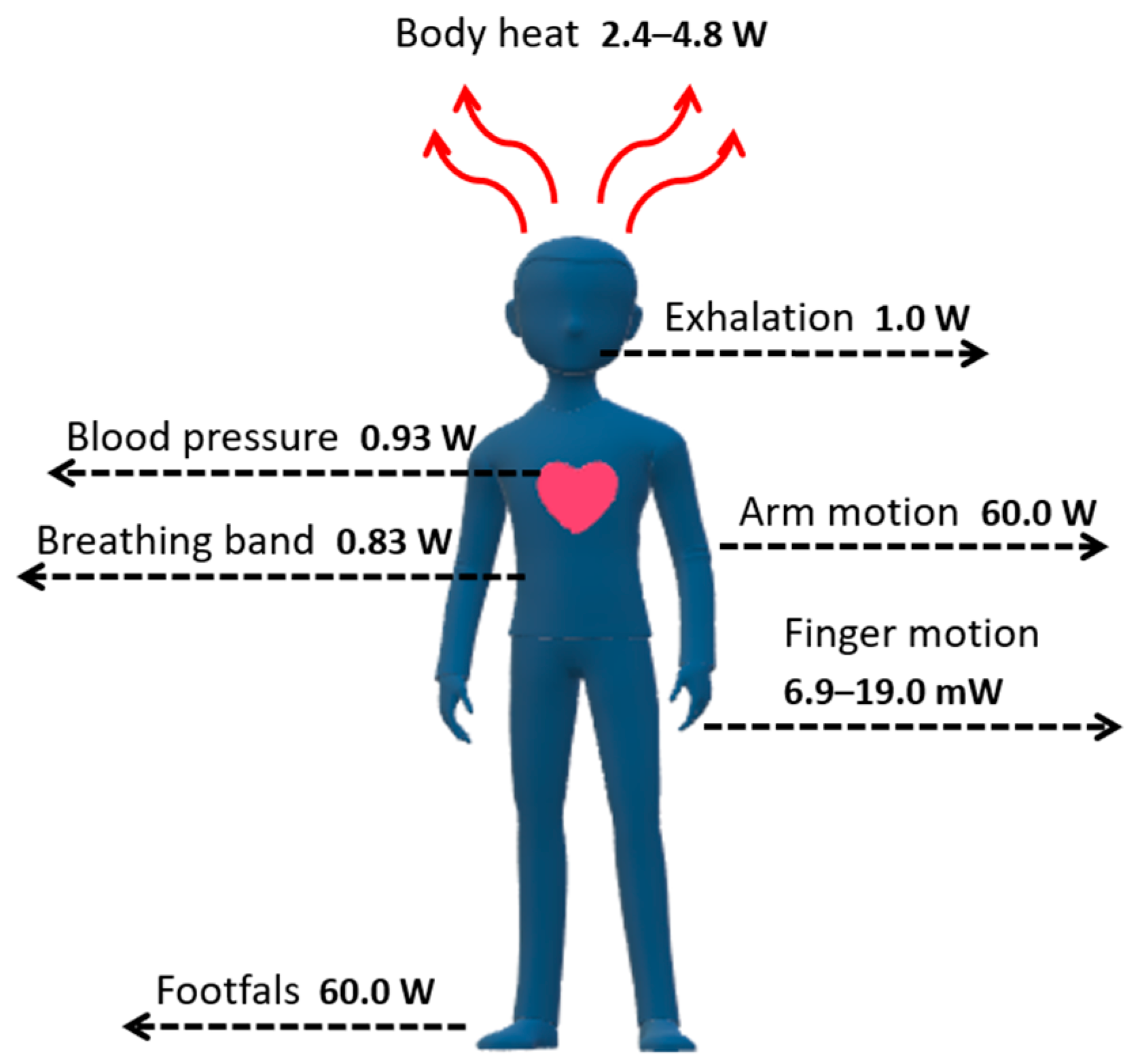



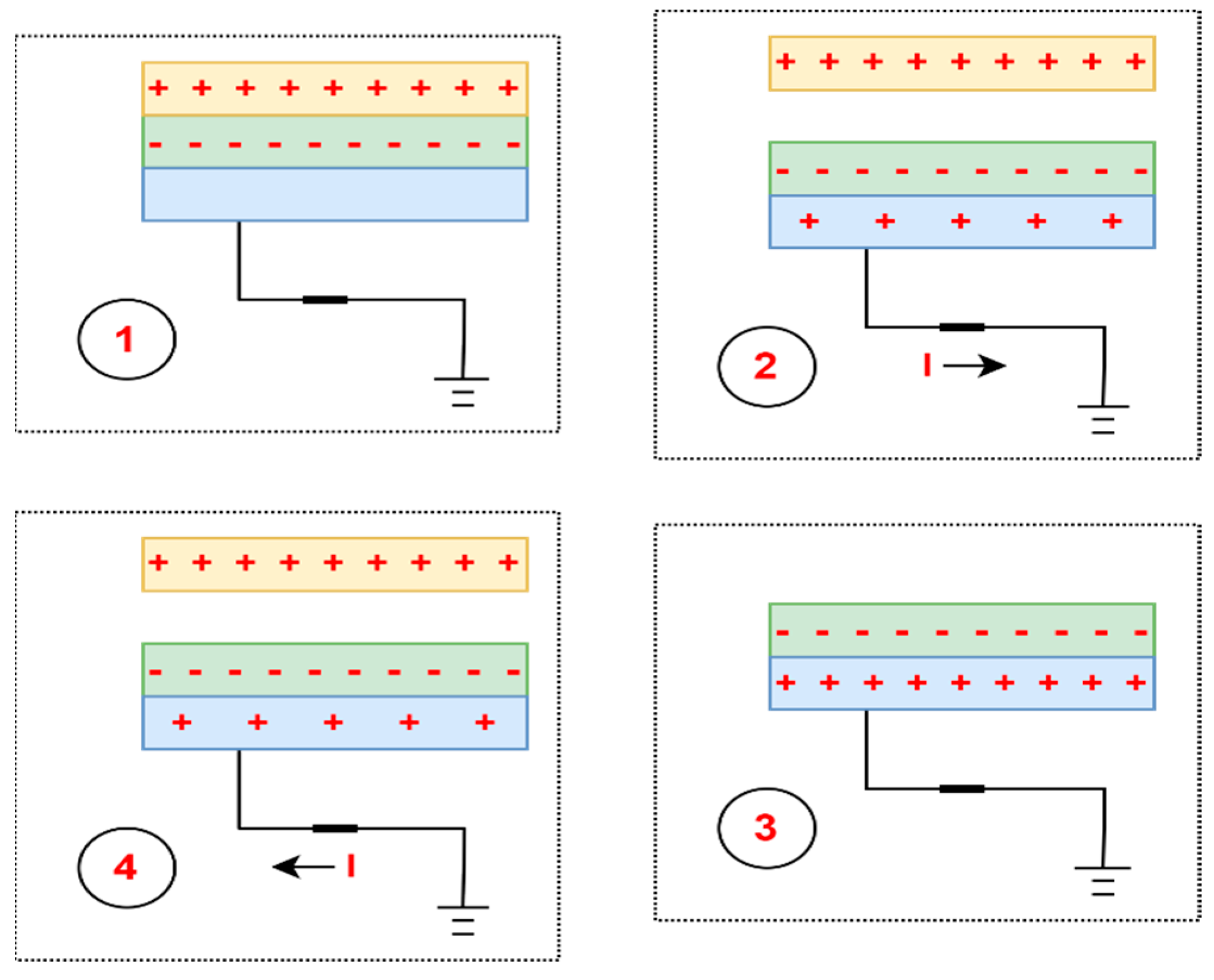


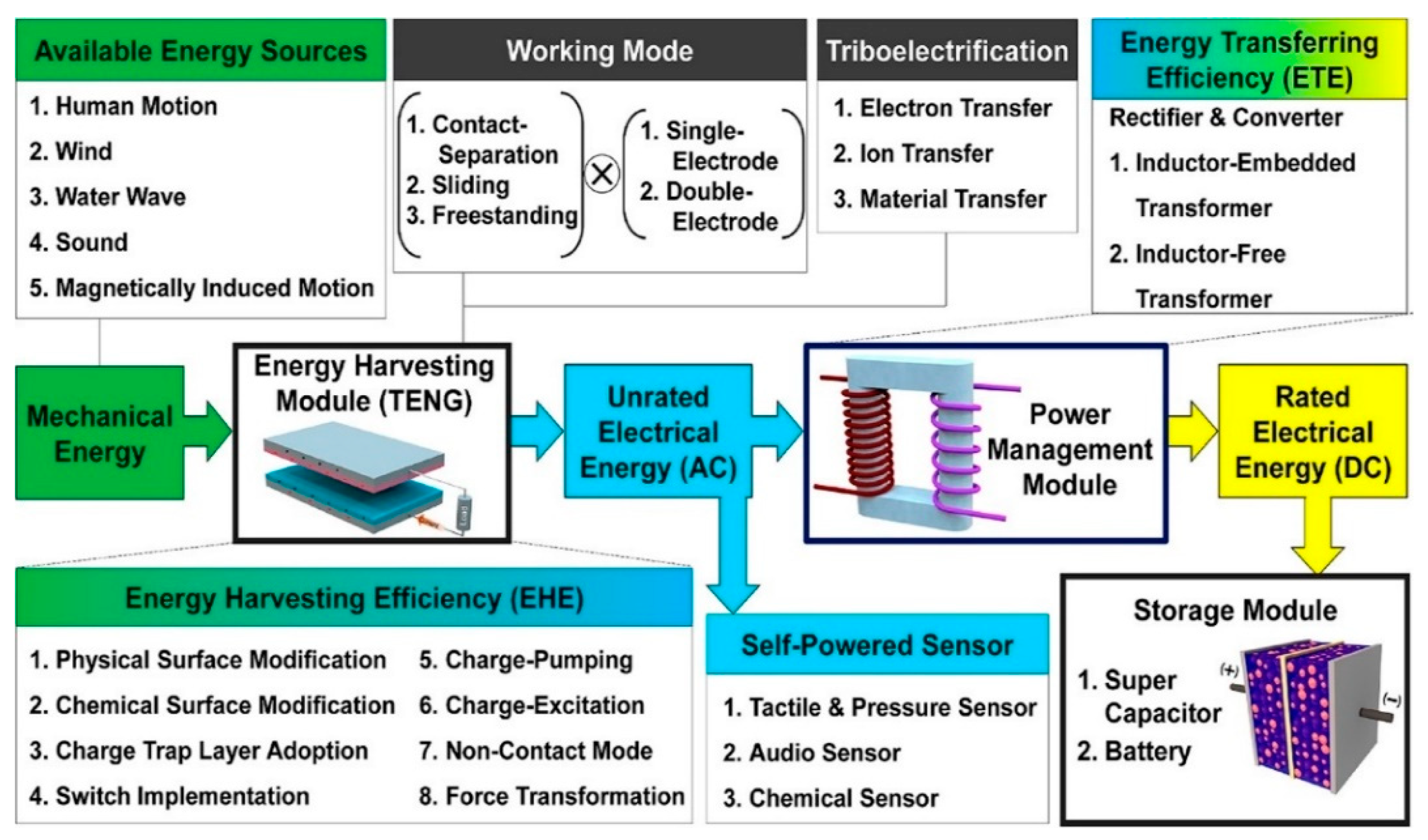

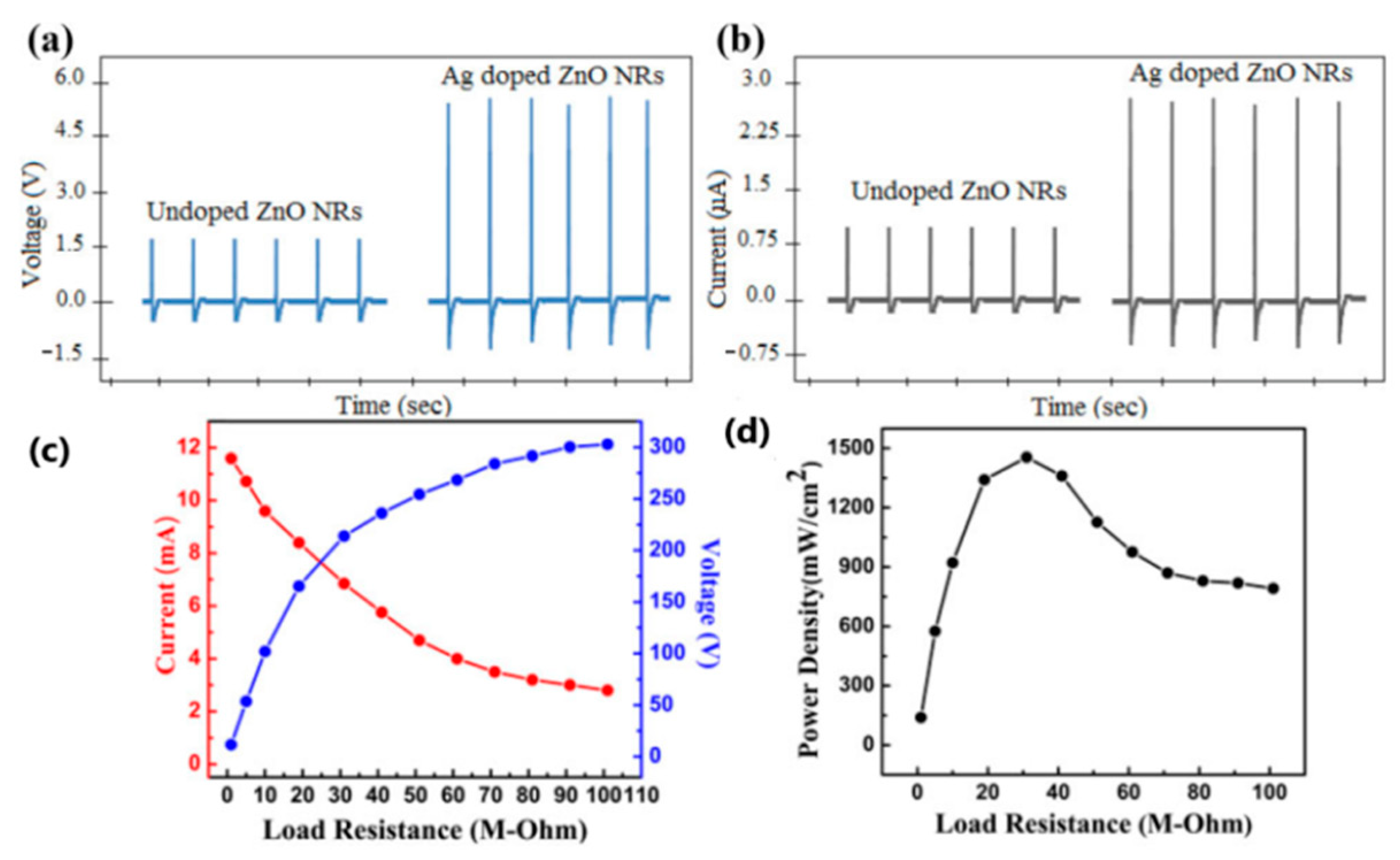




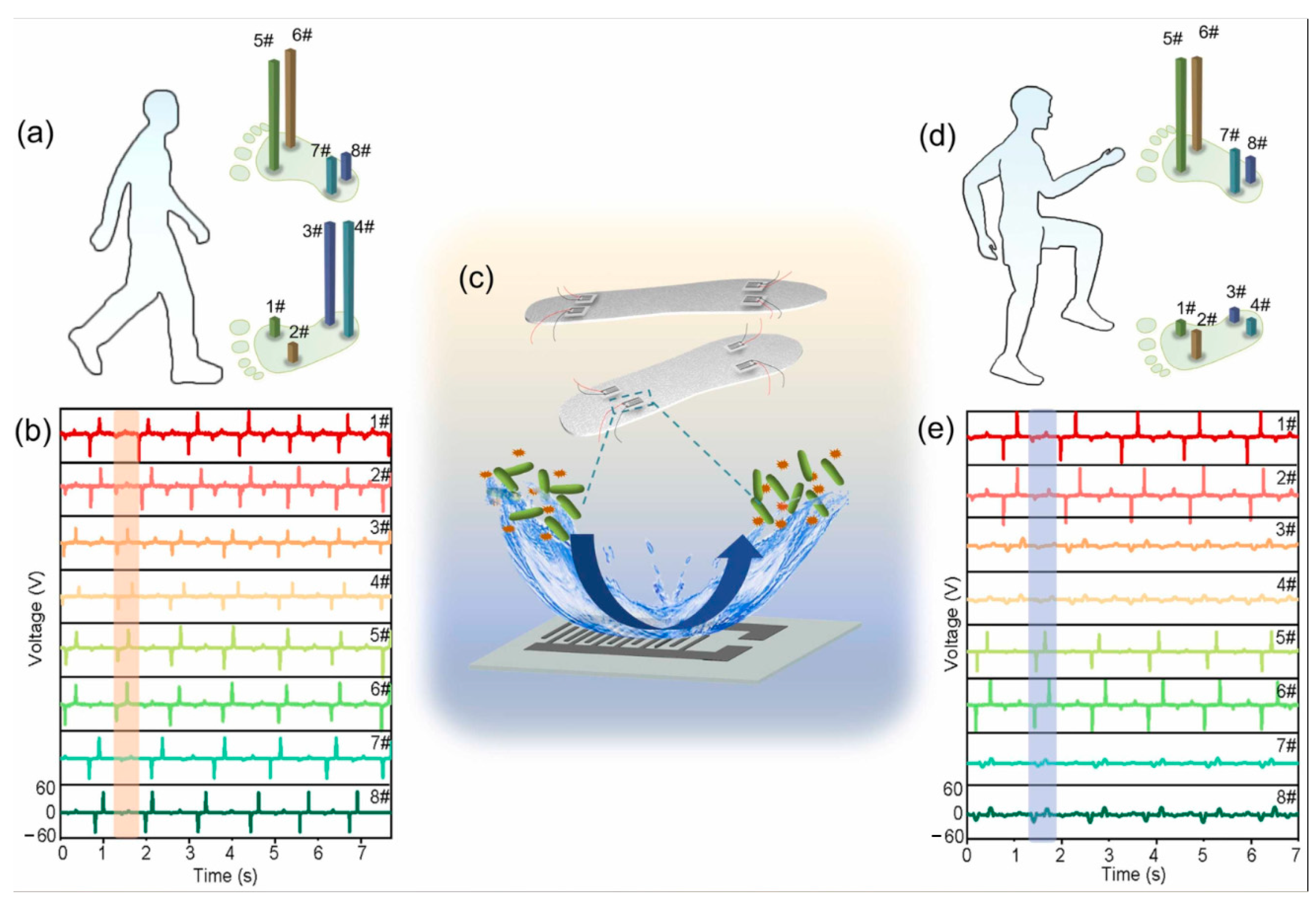
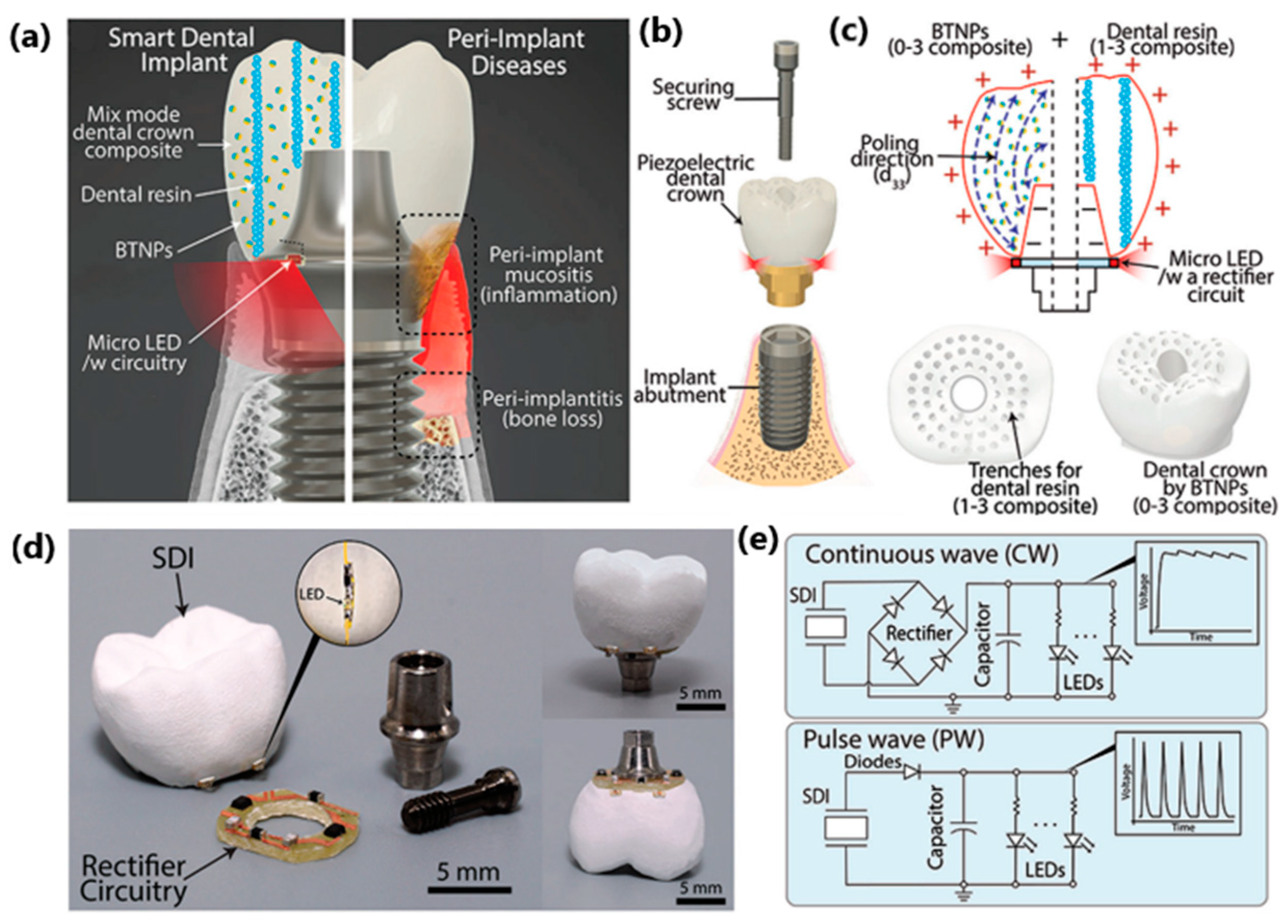
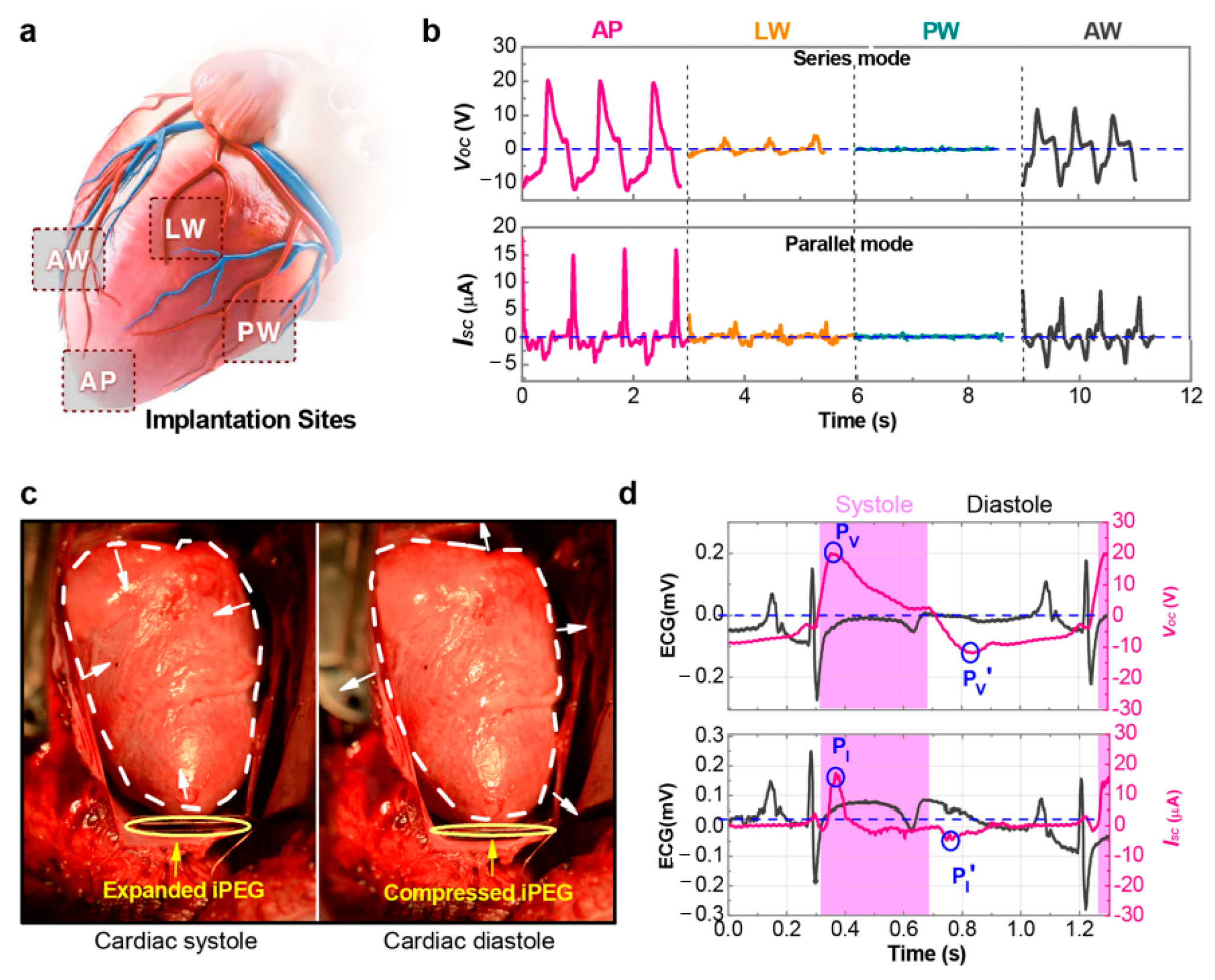








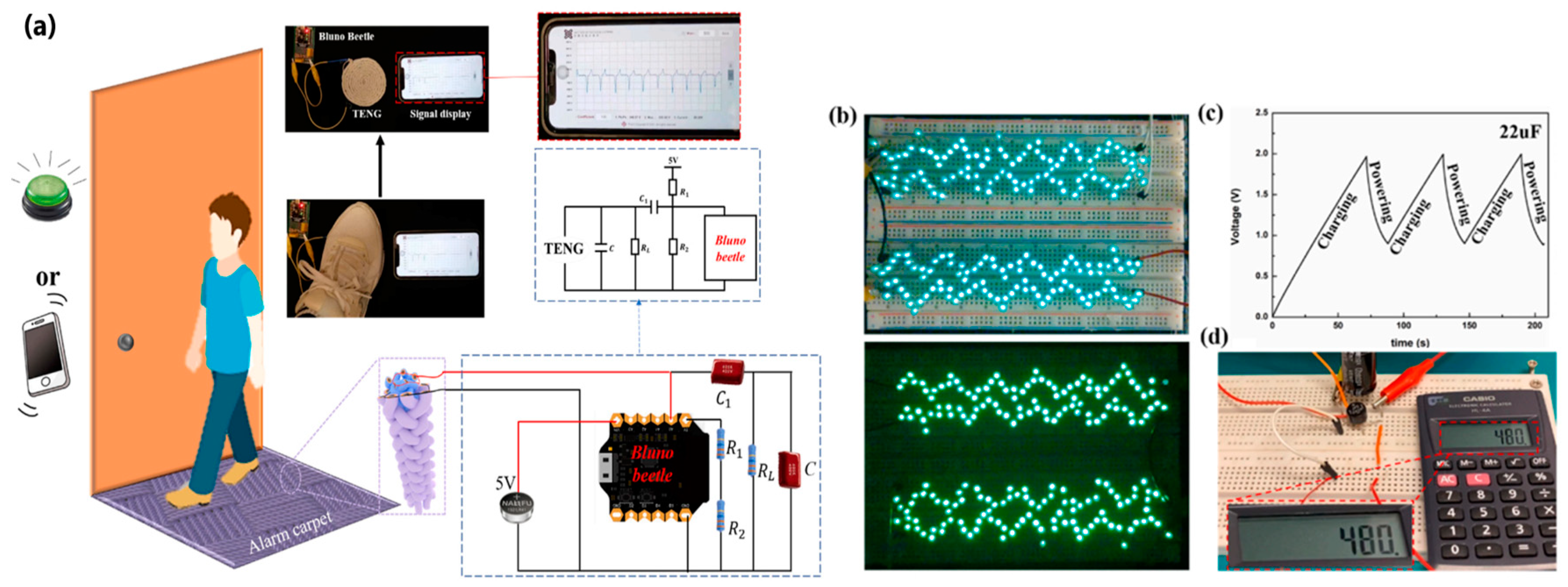
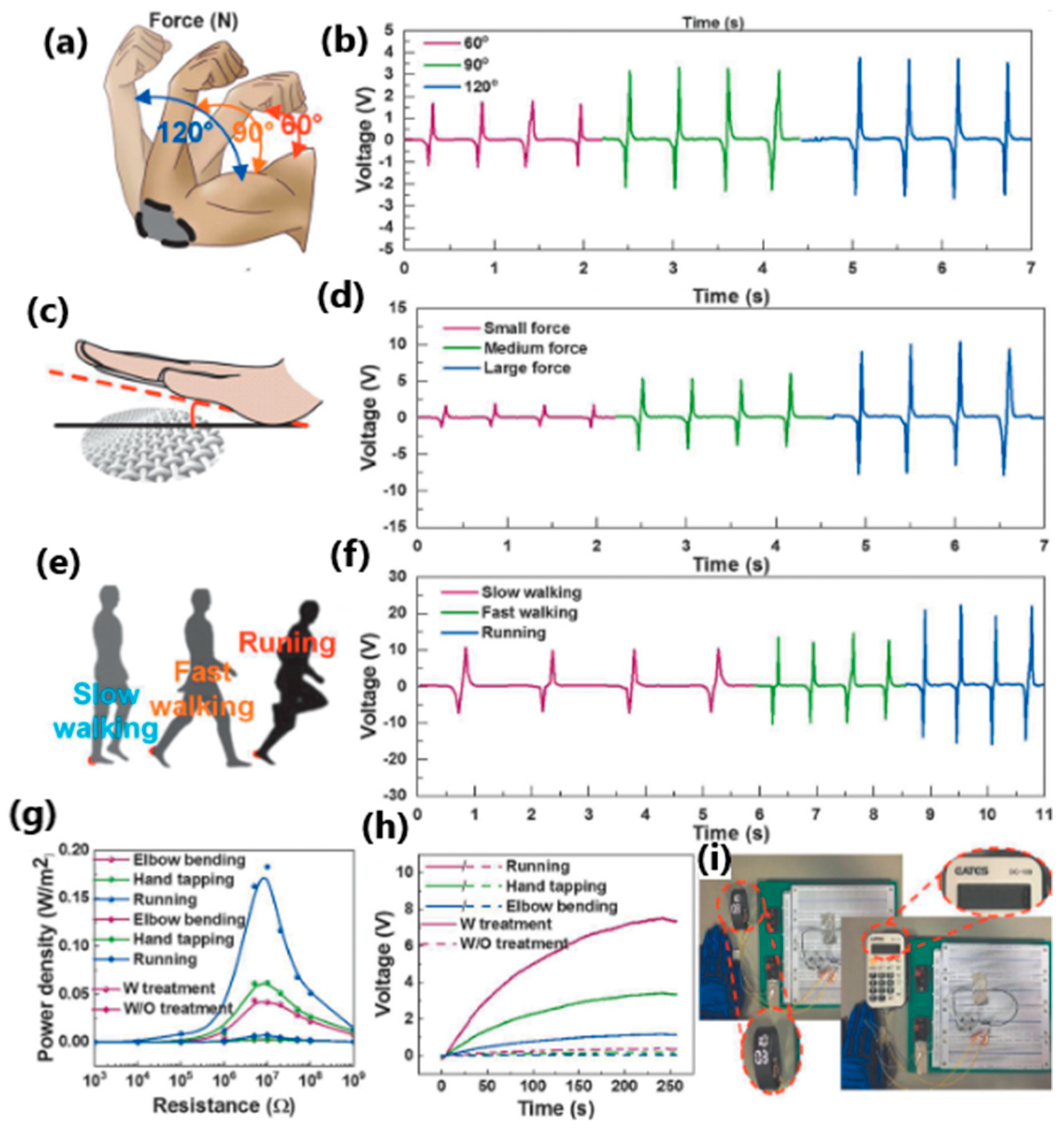
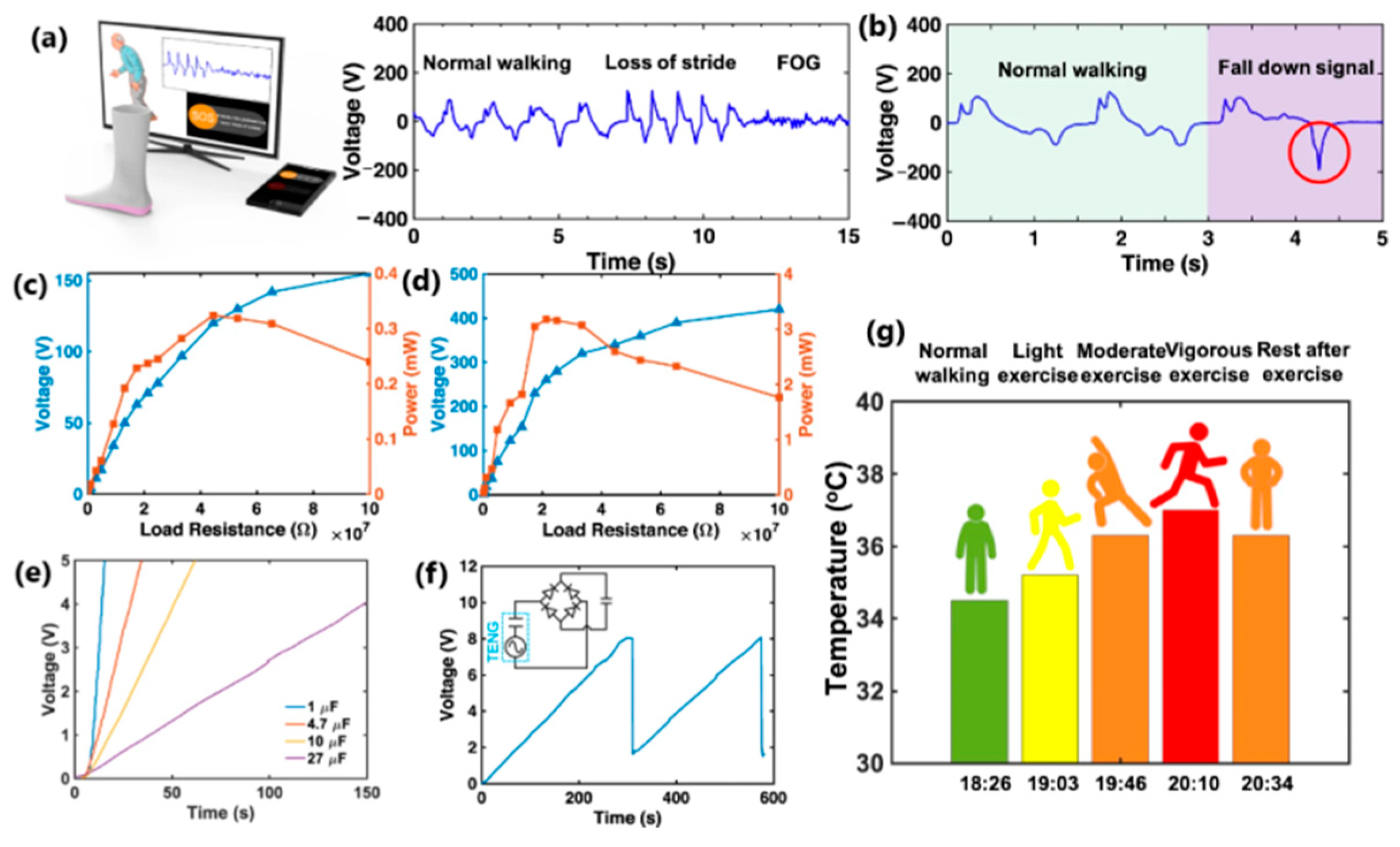





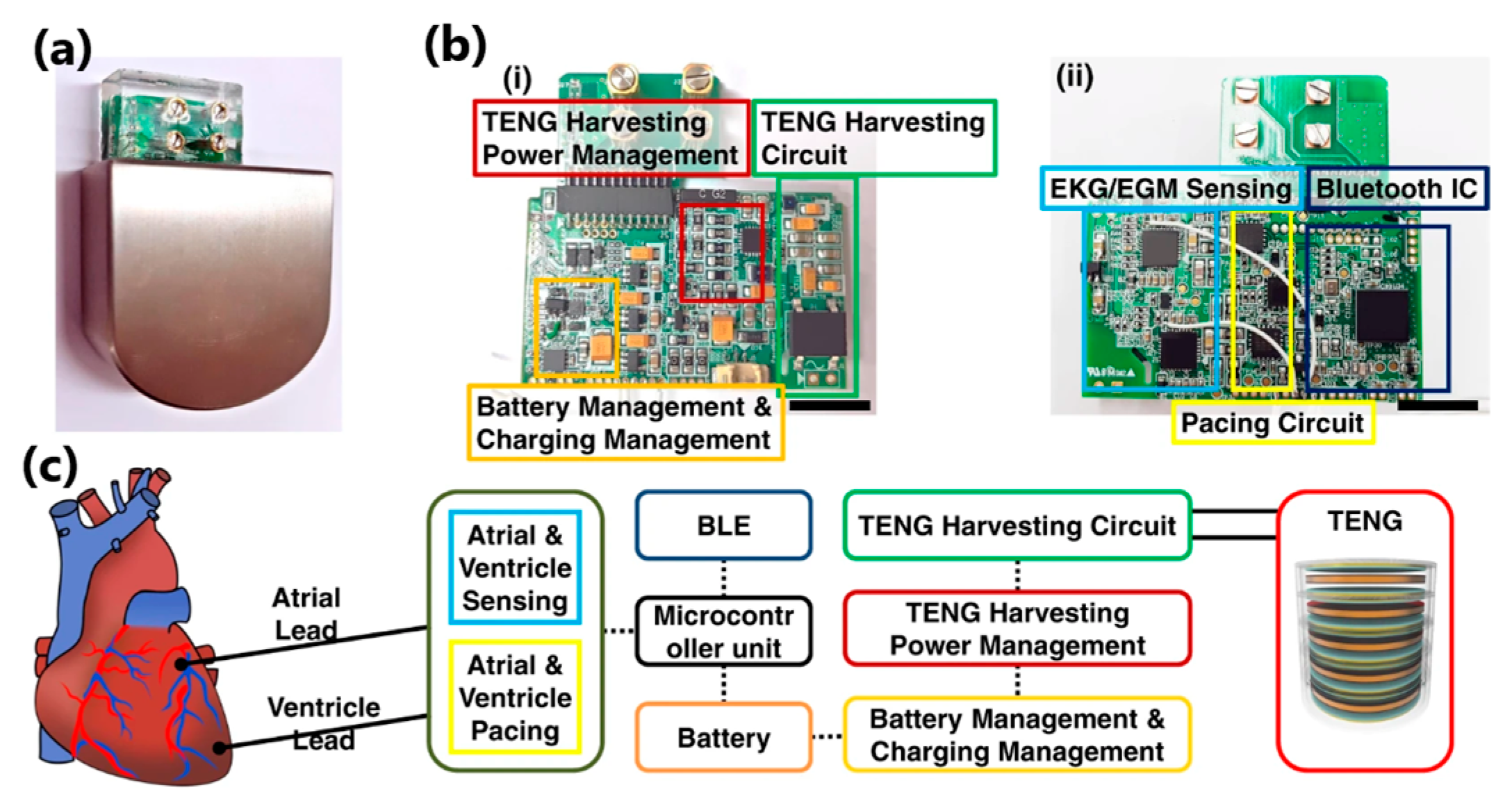



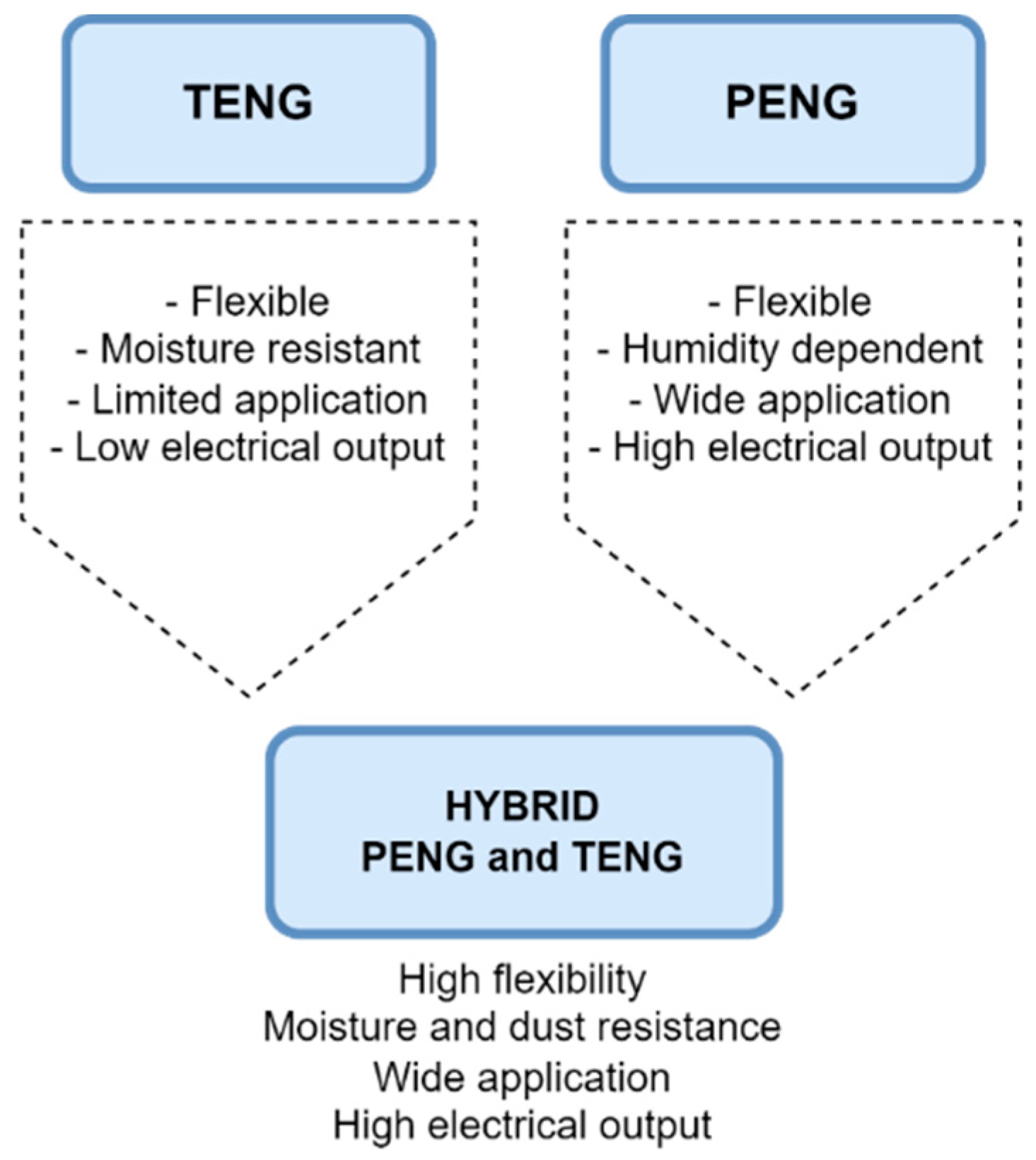

| Source | Human Body Energy | Energy Harvesting Technique |
|---|---|---|
| Chemical Energy | Glucose Lactate | Biofuel Cell |
| Thermal Energy | Body Temperature Evaporation Heat | Thermoelectric Generator |
| Evaporation Heat Respiration Heat | Pyroelectric Generator | |
| Biomechanical Energy | Body Motion | Piezoelectric Generator |
| Heart Beat | Triboelectric Generator | |
| Respiratory Movement | Electromagnetic Generator |
| Configuration Type | Advantages and Characteristics | Disadvantages |
|---|---|---|
| Unimorph or bimorph cantilever beam | Simple structure Low cost of fabrication Low resonance frequency High mechanical performance | Cannot resist a high impact force |
| Cymbal transducer | High energy output Can withstand high impact force | Limited applications |
| Circular diaphragm | Compatible with pressure working mode | Stiff High resonance frequency |
| Stacked configuration | Can withstand high mechanical load Compatible with pressure working mode | High stiffness |
| Piezoelectric Nanogenerator | Triboelectric Nanogenerator | ||
|---|---|---|---|
| Materials [175] | BaTiO3 and P(VDF-TrFE), AlN, polymer threads, ZnO nanowires and nanorods, PZT nanowires and ceramic, PVDF, PVDF-NaNbO3, PVDF polymer and nanofibers, Ceramic PMNZT, PTFE and Al, Al wires and PDMS | PTFE, FEP, PET, PDMS Metals—Cu, Al, Ni, Graphene Nitrile, silicone, Kapton film, PLGA-PCL, Silk fibroin, cellulose, chitin, Rice paper, egg white | |
| Structure [176] | Spiral twining/multilayer/winding Coaxial Core-sheath Woven (2D and 3D) Twisted Sandwich E-skin | Nanofiber stacking/embedded Coaxial Core-shell Knitted/woven (2D and 3D) Textile, fibre, yarn 3D printed Sandwich E-skin | |
| Output performance | Pulse sensor | 97.5 V; 1.16 µA [177] | 109 V; 2.73 µA [19] |
| E-skin | 3.2 V; 56.1 nA [133] | 220 V; 1.12 µA [178] | |
| Cardiac pacemaker | 3.5 mV; 60 nA [179] | 136 V; 2 µA [165] | |
| Material fabrication process |
|
| |
| Power density |
|
| |
| Sensing performance |
|
| |
| Scalability |
|
| |
| Durability |
|
| |
| Biocompatibility |
|
| |
| Energy Harvester | Materials | Position | Max Output Current (Isc) | Max Output Voltage (Voc) | Max Power Density or Output Power | Function | Ref. |
|---|---|---|---|---|---|---|---|
| PENG | PE braided layer, PET spacer layer, PTFE braided layer | Hand tapping, shoe insoles, fixed carpets | 0.25 μA | 32.0 V | 2.6 mW/m2 | Charging capacitors (0.22–4.7 μF), lightning 16 LEDs, walking- and-sitting state monitoring | [180] |
| PVDE-TrFE, gold, PI film | Eye, wrist, finger, abdominal area | 1.07 nA | 9.39 V | 2.84 μW/cm3 | Charging capacitors (4.7, 6.8, 10, 22 nF and 0.1 μF), lightning LED | [181] | |
| PANI coated pure P(VDF-TrFE) nanofibers, PANI coated P(VDF-TrFE)/BT nanocomposite nanofibers | Arm, knee, wrist, finger, and shoe sole | 3 μA | 68.0 V | 225 mW/m2 | Charging capacitors (1.0, 4.7, and 10 μF), powering more than 10 LEDs, self-powered wearable sensor | [182] | |
| PDMS, PZT/epoxy, Ag electrode, Polycarbonate | Sandwiched spirally coiled structure—walking | 196 μA | 36 V | 3.72 mW/cm2 | Powering 27 LEDs, energy storage (1 and 47 μF), powering hygrometer | [183] | |
| BaTiO3 nanoparticles, P9VDF-TrFE) matrix, silver flake | Mounted on a sock | 2 μA | 6 V | 1.4 μW/cm2 | Self-powered gait sensor | [184] | |
| PVDF nanofibers, ZnO flakes and rGO sheets | Implanted in the heart of an adult dog | 3 μA | 5 V | 138 μW/cm3 | Charging a 100 μF capacitor—powering a battery-free pacemaker | [185] | |
| PDMS-Ecoflex, LIG/PI, PVDF/CB, PVDF, PVDF/CA, PVDF-PDMS-CA MSc, Parylene C | Face mask—smiling, opening mouth, breathing in/out | 0.28 μA | 3 V | 0.85 × 10−2 μW/cm2 | Smart mask coupled with energy harvesting devices—anti-infection protection | [186] | |
| PI, ITO, Cr/Al, PET, PDMS + MASnBr3 composite | Finger (bending, tapping), heel (tapping, pressing) | 13.76 μA/cm2 | 18.8 V | 74.52 μW/cm2 | Charging capacitors (0.11, 2.2, and 4.7 μF)—driving a stopwatch and commercial LED | [187] | |
| TENG | Copper-nickel fabric, PDMS doped with BaTiO3 nanoparticles | Shoe insole, energy carpet | 137 μA | 480 V | 486 μW/cm2 | Shoe insole—lightning 700 LEDs; powering a digital watch, self-powered sensing system, human-falling detection | [188] |
| TENG—PDMS, PPy, rGO, PLA; SC—PDMS, MWCNTs, PVA/H3PO4, PPy, MnO2, rGO | Woven into the fabric (forearm) | 0.4 μA | 50 V | 17.9 μW/cm | Lighting 52 LEDs, powering the electronic watch, charging capacitors | [189] | |
| CMC/WPU/PEI/SiO2@TiO2 NPs | Hand, sleeve, knee and elbow joints, shoe insole | 6 μA | 204 V | 1.62 W/m2 | Charging capacitors (2.2, 4.7, 10 and 22 μF), powering electronic watch and calculator, self-powered strain/pressure sensor | [190] | |
| PVA/P(AM- co -AA)-Fe3+ DN gel | Cheek, forehead, lower limbs, throat, palm, elbow, index finger, knee joints | 1.2 μA | 238 V | 0.27 W/m2 | Charging capacitors (1, 4.7, 22, 47, 220 μF), powering 28 LEDs, calculator, body/joint motion detection and monitoring | [191] | |
| PDMS-PTFE/AgNWs-PVA hydrogel TENG | Fixed onto the fingers and soles of feet, wrist | 40 μA | 450 V | 3.07 W/m2 | Lighting 360 LEDs, self-powered sensing bracelet | [192] | |
| PVDS-coated CFP, CU-coated CFP | Patch films (working individually and installed on fingers) | 9.3 μA | 192 V | 736.7 mW/m2 | Charging capacitors (1–47 μF), powering 62 LEDs, calculator, thermohydrometer and electronic watch, HMI-recognition | [193] | |
| PET, Kapton, rubber band, Ag, PET/Kapton Spacer | TENG wrapped around finger, implemented into a floating backpack | 26 μA | 1334 V | 0.5 W/m2 | Lighting 360 LEDs, charging capacitors (1, 4.7, 22, 47 and 100 μF), powering electronic watch, stopwatch and calculator | [194] | |
| Mylar polyester film sheets, PET foam, Ni/Cu nonwoven polyester, PTFE film on Cu electrode | Miura-Ori tube structure | 131 μA | 1050 V | 40 mW | Powering LCD, calculator, wireless temperature sensor, charging 1200 μF capacitor, commercial Li battery, heart rate monitoring | [89] | |
| Hybrid PENG-TENG | Lead-free perovskite/PVDF-HFP, SEBS | Top and bottom side of a shoe pad | 25 μA | 290 V | - | Powering 100 LEDs, charging capacitors (1–100 μF) | [195] |
| PET, Copper, Kapton, PVDF, Aluminium | Add-on fabric patch (knee, elbow), shoe insole | 1–2 μA | 1–5 V | - | Illuminating LED, charging a 220 μF capacitor | [196] | |
| PVDF films, Al electrode, Acrylic | Shoe insole | ~3 μA | ~120 V | 127 μW | Lighting LEDs, wireless sensor network | [197] | |
| BTO-PDMS, PDMS-PTFE, Ag | Kirigami patch—stretching, pressing, twisting | 2 μA | 255 V | 7.5 W/m2 | Illuminating 118 LEDs, charging capacitors (0.47, 4.7, 10, 47 μF), charging calculator, sensor | [198] | |
| PEDOT:PSS, PTFE film, Al, Au/Cr, PZT, Ag, Cu | Cotton socks | 4.5 μA | 196 V | 128 μW/cm2 | Gait analysis, sweat detection, monitoring physiological signals | [199] | |
| MoS2 on Cu foil, ZnO, PVDF | Heel, elbow, machine vibration | 4.6 μA | 140 V | 256 μW/cm2 | Powering 33 LEDs, calculator and wristwatch, physiological signal monitoring | [200] | |
| PTFE yarn, BaTiO3/PDMS yarn, AgNW/PDMS yarn, metal Cu wire, Cu coil-spring | Stretching, bend-stretching, squeezing, tapping; knee, elbow, wrist | 2 μA | 400 V | 91.6 mW/m2 | Charging capacitors (10, 22, 33, 47, 100 μF), powering 130 LEDs, self-powered sensing device | [201] |
Disclaimer/Publisher’s Note: The statements, opinions and data contained in all publications are solely those of the individual author(s) and contributor(s) and not of MDPI and/or the editor(s). MDPI and/or the editor(s) disclaim responsibility for any injury to people or property resulting from any ideas, methods, instructions or products referred to in the content. |
© 2024 by the authors. Licensee MDPI, Basel, Switzerland. This article is an open access article distributed under the terms and conditions of the Creative Commons Attribution (CC BY) license (https://creativecommons.org/licenses/by/4.0/).
Share and Cite
Gołąbek, J.; Strankowski, M. A Review of Recent Advances in Human-Motion Energy Harvesting Nanogenerators, Self-Powering Smart Sensors and Self-Charging Electronics. Sensors 2024, 24, 1069. https://doi.org/10.3390/s24041069
Gołąbek J, Strankowski M. A Review of Recent Advances in Human-Motion Energy Harvesting Nanogenerators, Self-Powering Smart Sensors and Self-Charging Electronics. Sensors. 2024; 24(4):1069. https://doi.org/10.3390/s24041069
Chicago/Turabian StyleGołąbek, Justyna, and Michał Strankowski. 2024. "A Review of Recent Advances in Human-Motion Energy Harvesting Nanogenerators, Self-Powering Smart Sensors and Self-Charging Electronics" Sensors 24, no. 4: 1069. https://doi.org/10.3390/s24041069
APA StyleGołąbek, J., & Strankowski, M. (2024). A Review of Recent Advances in Human-Motion Energy Harvesting Nanogenerators, Self-Powering Smart Sensors and Self-Charging Electronics. Sensors, 24(4), 1069. https://doi.org/10.3390/s24041069








